人教版新课标高中英语必修二教案合集
新课标人教版高中英语必修二教案
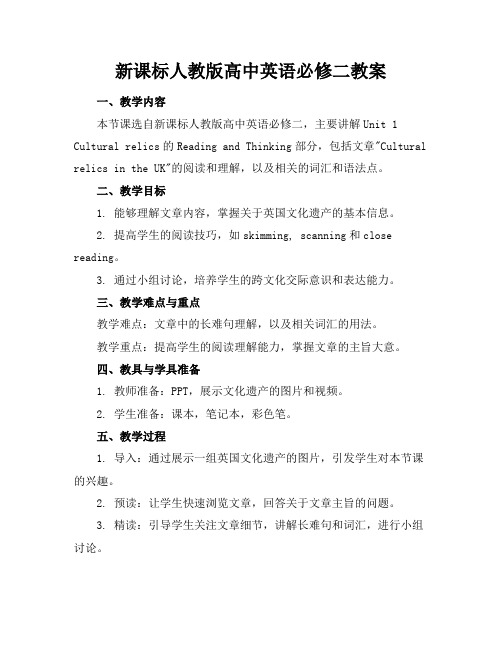
新课标人教版高中英语必修二教案一、教学内容本节课选自新课标人教版高中英语必修二,主要讲解Unit 1 Cultural relics的Reading and Thinking部分,包括文章"Cultural relics in the UK"的阅读和理解,以及相关的词汇和语法点。
二、教学目标1. 能够理解文章内容,掌握关于英国文化遗产的基本信息。
2. 提高学生的阅读技巧,如skimming, scanning和close reading。
3. 通过小组讨论,培养学生的跨文化交际意识和表达能力。
三、教学难点与重点教学难点:文章中的长难句理解,以及相关词汇的用法。
教学重点:提高学生的阅读理解能力,掌握文章的主旨大意。
四、教具与学具准备1. 教师准备:PPT,展示文化遗产的图片和视频。
2. 学生准备:课本,笔记本,彩色笔。
五、教学过程1. 导入:通过展示一组英国文化遗产的图片,引发学生对本节课的兴趣。
2. 预读:让学生快速浏览文章,回答关于文章主旨的问题。
3. 精读:引导学生关注文章细节,讲解长难句和词汇,进行小组讨论。
4. 课堂实践:让学生根据文章内容,进行角色扮演,模拟导游介绍英国文化遗产。
5. 例题讲解:针对文章中的重点语法和词汇,设计相关练习题,进行讲解。
6. 随堂练习:让学生完成课后练习,巩固所学知识。
六、板书设计1. Cultural relics in the UK2. 关键词汇:relic, preserve, significance, identity, contribute3. 重点句子:①The Tower of London, as a symbol ofBritish royal power, has a long history. ②St onehenge, an ancient mysterious monument, attracts numerous visitors every year.七、作业设计1. 作业题目:(1)Summarize the main idea of the article in one sentence.(2)Translate the following sentences into Chinese:①The Tower of London, as a symbol of British royal power, has a long history. ②Stonehenge, an ancient mysterious monument, attracts numerous visitors every year.2. 答案:(1)This article introduces several cultural relics in the UK, including the Tower of London and Stonehenge, anddiscusses their historical significance and contributions to British identity.(2)①伦敦塔作为英国皇家权力的象征,拥有悠久的历史。
新课标人教版高中英语必修二教案
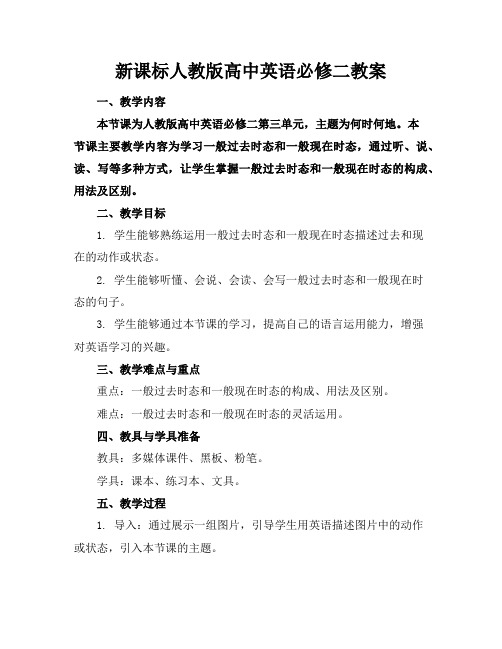
新课标人教版高中英语必修二教案一、教学内容本节课为人教版高中英语必修二第三单元,主题为何时何地。
本节课主要教学内容为学习一般过去时态和一般现在时态,通过听、说、读、写等多种方式,让学生掌握一般过去时态和一般现在时态的构成、用法及区别。
二、教学目标1. 学生能够熟练运用一般过去时态和一般现在时态描述过去和现在的动作或状态。
2. 学生能够听懂、会说、会读、会写一般过去时态和一般现在时态的句子。
3. 学生能够通过本节课的学习,提高自己的语言运用能力,增强对英语学习的兴趣。
三、教学难点与重点重点:一般过去时态和一般现在时态的构成、用法及区别。
难点:一般过去时态和一般现在时态的灵活运用。
四、教具与学具准备教具:多媒体课件、黑板、粉笔。
学具:课本、练习本、文具。
五、教学过程1. 导入:通过展示一组图片,引导学生用英语描述图片中的动作或状态,引入本节课的主题。
2. 呈现:教师通过多媒体课件,展示一般过去时态和一般现在时态的句子,让学生感知两种时态的差别。
3. 讲解:教师在黑板上用粉笔讲解一般过去时态和一般现在时态的构成、用法及区别,让学生明确两种时态的规则。
4. 练习:学生根据教师提供的场景,用一般过去时态和一般现在时态进行造句,教师及时纠正学生的错误。
5. 互动:学生分组进行角色扮演,用一般过去时态和一般现在时态进行对话,培养学生的口语表达能力。
6. 巩固:教师设计一些练习题,让学生书面完成,检验学生对一般过去时态和一般现在时态的掌握程度。
六、板书设计板书一般过去时态和一般现在时态板书内容:一般过去时态:构成:主语+动词过去式用法:描述过去的动作或状态一般现在时态:构成:主语+动词原形用法:描述现在的动作或状态七、作业设计1. 请用一般过去时态和一般现在时态分别描述一下你昨天和今天的活动。
答案:Yesterday, I watched a movie with my friends.Today, I am doing homework.2. 请用一般过去时态和一般现在时态写一段关于你最喜欢的季节的描述。
高中英语必修二教案

高中英语必修二教案【篇一:人教新课标高一英语必修2_unit_1教案】unit 1cultural relicsi. 单元教学目标ii. 目标语言ii. 教材分析与教材重组1. 教材分析本单元以cultural relics为话题,旨在通过单元教学使学生了解世界文化遗产,学会描述它们的起源,发展和保护等方面的情况,复习并掌握定语从句,能就如何保护和处理世界文化遗产给出自己的观点。
1.1 warming up 热身部分提供了四幅图片,设计了三个问题让学生交流对于cultural relic的了解,并就此进行讨论。
这部分的目的是呈现本单元的中心话题“文化遗产”。
1.2 pre-reading 是reading的热身部分,提供了ambers的图片并就此此设计了两个问题。
这两个问题极易引起学生对amber的兴趣,并能引导学生对课文进行prediction。
1.3 reading是关于寻找丢失了的普鲁士国王威廉一世送给俄罗斯沙皇的那个琥珀房子的建立、转让、被毁、重建的整个历史。
设计这篇文章的目的是让学生了解什么是文化遗产以及讨论保护和重建文化从文化遗产的重要性和必要性。
1.4 comprehending既有知识性的问题,同时又跳出了课文,对文章进行整体评价,由易到难,有较好的梯度,全面考查学生对文章的理解。
exercise 1将人物及相关事件匹配,检验学生对文章细节的理解;exercise 2 将所给的问题与段落匹配,是段落大意理解题;exercise 3安排了对于重建lost cultural relics的意义进行讨论,使得学生能对本单元的主题进行较为深入的探讨。
1.5 learning about language 分discovering useful words and expressions 和discovering useful structures两部分。
其中第一部分的exercise 1着重训练对英语单词解释的理解。
人教版高中英语必修第二册全册教学设计汇总
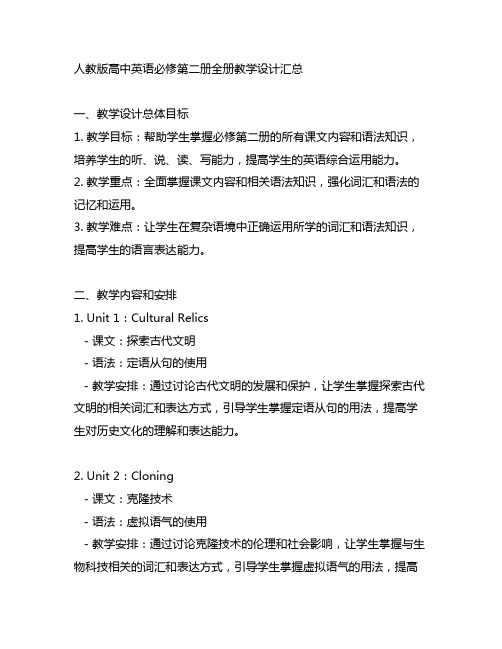
人教版高中英语必修第二册全册教学设计汇总一、教学设计总体目标1. 教学目标:帮助学生掌握必修第二册的所有课文内容和语法知识,培养学生的听、说、读、写能力,提高学生的英语综合运用能力。
2. 教学重点:全面掌握课文内容和相关语法知识,强化词汇和语法的记忆和运用。
3. 教学难点:让学生在复杂语境中正确运用所学的词汇和语法知识,提高学生的语言表达能力。
二、教学内容和安排1. Unit 1:Cultural Relics- 课文:探索古代文明- 语法:定语从句的使用- 教学安排:通过讨论古代文明的发展和保护,让学生掌握探索古代文明的相关词汇和表达方式,引导学生掌握定语从句的用法,提高学生对历史文化的理解和表达能力。
2. Unit 2:Cloning- 课文:克隆技术- 语法:虚拟语气的使用- 教学安排:通过讨论克隆技术的伦理和社会影响,让学生掌握与生物科技相关的词汇和表达方式,引导学生掌握虚拟语气的用法,提高学生对科技进步的理解和表达能力。
3. Unit 3:Travel Journal- 课文:游记- 语法:名词性从句的使用- 教学安排:通过学习游记的写作技巧和语言表达,让学生掌握与旅行相关的词汇和表达方式,引导学生掌握名词性从句的用法,提高学生对旅行经历的表达能力。
4. Unit 4:Wildlife Protection- 课文:野生动物保护- 语法:情态动词的使用- 教学安排:通过探讨野生动物保护的挑战和方法,让学生掌握与环保相关的词汇和表达方式,引导学生掌握情态动词的用法,提高学生对环保议题的理解和表达能力。
5. Unit 5:Music- 课文:音乐- 语法:定语从句和名词性从句的复合句- 教学安排:通过学习不同类型音乐的特点和音乐家的成就,让学生掌握音乐方面的词汇和表达方式,引导学生掌握定语和名词性从句的复合句结构,提高学生对音乐艺术的理解和表达能力。
6. Unit 6:Language- 课文:语言- 语法:宾语从句和名词性从句的区别及使用- 教学安排:通过探讨不同语言的重要性和影响,让学生掌握与语言学习相关的词汇和表达方式,引导学生区分宾语从句和名词性从句的使用,并正确运用它们,提高学生对语言学习的理解和表达能力。
新课标人教版高中英语必修二教案
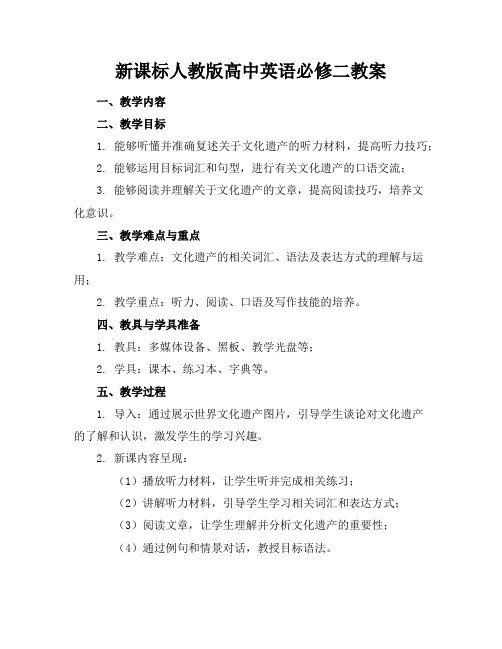
新课标人教版高中英语必修二教案一、教学内容二、教学目标1. 能够听懂并准确复述关于文化遗产的听力材料,提高听力技巧;2. 能够运用目标词汇和句型,进行有关文化遗产的口语交流;3. 能够阅读并理解关于文化遗产的文章,提高阅读技巧,培养文化意识。
三、教学难点与重点1. 教学难点:文化遗产的相关词汇、语法及表达方式的理解与运用;2. 教学重点:听力、阅读、口语及写作技能的培养。
四、教具与学具准备1. 教具:多媒体设备、黑板、教学光盘等;2. 学具:课本、练习本、字典等。
五、教学过程1. 导入:通过展示世界文化遗产图片,引导学生谈论对文化遗产的了解和认识,激发学生的学习兴趣。
2. 新课内容呈现:(1)播放听力材料,让学生听并完成相关练习;(2)讲解听力材料,引导学生学习相关词汇和表达方式;(3)阅读文章,让学生理解并分析文化遗产的重要性;(4)通过例句和情景对话,教授目标语法。
3. 情景实践:组织学生进行小组讨论,运用所学词汇、语法及表达方式,讨论我国的文化遗产。
4. 例题讲解:针对本节课所学内容,设计相关练习题,进行讲解和指导。
5. 随堂练习:布置与新课内容相关的练习题,巩固所学知识。
六、板书设计1. Cultural heritage2. 主要内容:文化遗产相关词汇、语法、句型及文章框架七、作业设计1. 作业题目:(2)根据所给词汇,编写一段关于文化遗产的对话。
(3)阅读短文,回答问题。
2. 答案:(1)The Great Wall is an important cultural heritage of our country.(2)Example: A: Have you ever been to the Forbidden City? B: Yes, it's a wonderful place, full of cultural heritage.(3)Answers:八、课后反思及拓展延伸2. 拓展延伸:鼓励学生课下了解更多关于文化遗产的知识,提高文化素养,为下一节课的学习做好准备。
【新教材】人教版高中英语必修第二册全册精编教案设计.docx
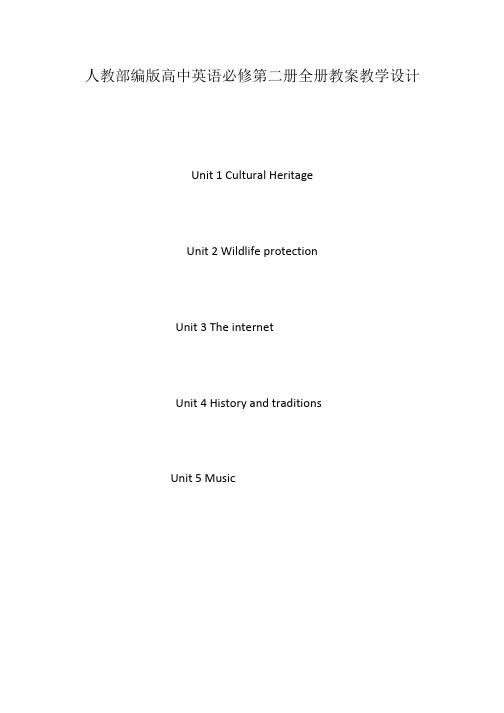
人教部编版高中英语必修第二册全册教案教学设计Unit 1 Cultural HeritageUnit 2 Wildlife protectionUnit 3 The internetUnit 4 History and traditionsUnit 5 MusicUnit 1 Cultural HeritagePeriod 2 Reading and Thinking:From Problems to Solutions【教材分析】1.This section focuses on "Understanding how a problem was solved,,, which is aimed to guide students to analyze and discuss the challenges and problems faced by cultural heritage protection during the construction of Aswan Dam, as well as the solutions. On the basis of understanding, students should pay attention to the key role of international cooperation in solving problems, and attach importance to the balance and coordination between cultural heritage protection and social and economic development. Students are encouraged to face challenges actively, be good at cooperation, and make continuous efforts to find reasonable ways and means to solve problems.【教学目标】1.Enable students to understand the main information and text structure of the reading text;2.Motivate students to use the reading strategy "make a timeline,, according to the appropriate text genre;3.Enable students to understand how a problem was solved;4.Enable students to understand the value of protecting cultural heritage by teamwork and global community;【教学重难点】1.Guide students to pay attention to reading strategies, such as prediction, self-questioning and scanning.2.Help students sort out the topic language about protecting cultural relics and understand the narrative characteristics of "time-event" in illustrative style3.Lead students to understand the value of protecting cultural heritage by teamwork and global community;【教学过程】1.PredictionStep 1 Predicting the main idea of the passageLook at the title and the pictures, and then predict what the passage will be about.Q: What will be talked about?Step 2: Fast reading tasksTask of the first fast reading:Read quickly and figure out the key words of each paragraph.•Paragraph 1: challenge•Paragraph 2: proposal led to protests•Paragraph 3: committee established•Paragraph 4: brought together•Paragraph 5: success•Paragraph 6: spiritTask of the second fast reading:1.Why did the Egyptian government want to build a new dam in the 1950s?2.Why did the building of the dam lead to protests?3.How did the government save the cultural relics?4.Which one can describe the project?A. Successful.B. Negative.C. Useless.D. Doubtful.5.What can be learned from the Aswan Dam project?Step 3: Careful reading tasksRead more carefully and answer the following questions.1.What do "problems" refer to and what do "solutions" refer to?2.Find out the numbers in paragraph four and explain why the author used exact numbers instead of expressions like many?3.What can you infer from "Over the next 20 years, thousands of engineers and workers rescued 22 temples and countless cultural relics"?4.What can you infer from "Fifty countries donated nearly 80 million to the project"?The project cost a lot of money.5.Before the building of the dam, what problems did the Nile River bring to the Egyptian?6.What words can you think of to describe the working process of the project?Step 4: ConsolidationDivide the passage into three parts and get the main idea of each part.Part 1 (Paragraph 1)The introduction of the topicKeeping the right balance between progress and the protection of cultural sites is a big challenge.Part 2 (Paragraphs 2-5)The process of saving cultural relics•Big challenges can sometimes lead to great solutions.•The Egyptian government wanted to build a new dam, which would damage many cultural relics.•The government turned to the UN for help.•Experts made a proposal for how to save cultural relics after a lot of efforts and the work began.•Cultural relics were taken down and moved to a safe place.•Countless c ultural relics were rescued.•The project was a success.Part 3 (Paragraph 6)The summary of the textThe global community can sometimes provide a solution to a difficult problem for a single nation.Step 5: Critical thinking:1.How to deal with the construction and the protection of cultural relics?2.As students, what should we do to protect our cultural relics?Step 6: summaryStep 7 Homework:Review what we have learned and find out the key language points in the text. 板书设计教学反思Unit 2 Wildlife ProtectionReading for Writing【教材分析】The activity theme is "making effective poster,,. The protection of wildlife needs the participation of the whole society. It is imperative to educate the public on wildlife protection and arouse the public's awareness and enthusiasm for wildlife protection. Teenagers are not only the main body of education, but also the "ambassador" of publicity and promotion. To make posters, students need to understand and study the situation of endangered animals and think about protection measures. In the process of reading and understanding the content of posters and making posters, students should be trained to master and use the style of posters, and their social responsibility and sense of responsibility should be cultivated.The reading text is two posters. The first poster, "give ugly a chance!" calls on people to protect all kinds of wild animals and not treat them differently because of personal likes and dislikes. No matter how beautiful or ugly animals are, they have the meaning and value of existence. The world is beautiful because of the diversity of biology. The article uses the tone of statement to make people unconsciously accept the author's point of view. The second POSTER "don't make paper with my home!,, adopts anthropomorphic rhetoric and takes koala's heart cry as the title, criticizing those behaviors of deforestation and destruction of animal homes. The text is a progressive explanation of the title. Exclamatory sentences and rhetorical sentences are used in this paper, which express the author's attitude and point of view. In addition, the title ofthese two posters uses exclamation sentences with strong appeal and emotional color, coupled with vivid pictures, making the posters more powerful.【教学目标】1.Cultivate students to acquire some features about an English poster by reading the text.2.Help students to write an English poster about animal protection properly using some newly acquired writing skills in this period.3.Develop students' writing and cooperating abilities.4.Strengthen students' great interest in writing discourses.【教学重难点】1.Stimulate students to have a good understanding of how to write an English poster properly.2.Cultivate students to write an English poster properly and concisely.【教学过程】Step 1: Lead inDo you want to be a volunteer of a pefs shelter? Why?Yes, I want to be a volunteer of it, because I want to help the pets, which are lovely and cute. I like them very much.Step 2: Read to discover details concerning the main details of the news report.I.Read the news report and then solve the questions below.1.Who started the rescue centre called the Small Friends Pet Shelter?A group of high school students and parents.2.What did the young people do in the shelter?Take care of animals.3.How do the young people think of their work?Worthwhile4.What help does the centre need?Volunteers, time and love.II. Read the text again and then choose the best answer.1.What should we do when we protect the wildlife animals?A.Treat all the wild animals equally.B.Only pay attention to less cute animals.C.Pay attention to cute animals.D.Care about endangered wildlife animals.2.Whafs the bad effect of cutting down billions of trees to make paper for humans?A.Make a lot of animals homeless.B.Make a number of wildlife animals dying out.C.The animals5 habitat is being destroyed.D.All of them.【答案】ADCStep 3: Study the organization and language features.1.Read the passage more carefully and write down the outline of the text.1.The Small Friends Pet Shelter was started by a group of high school students and their parents when they started to see many pets (that were left behind after their families moved away).译文:当一些高中生和他们的父母看到在主人搬走后,时,们建立了小朋友宠物收容所。
高中英语优秀教案必修二(人教版)全套(下)
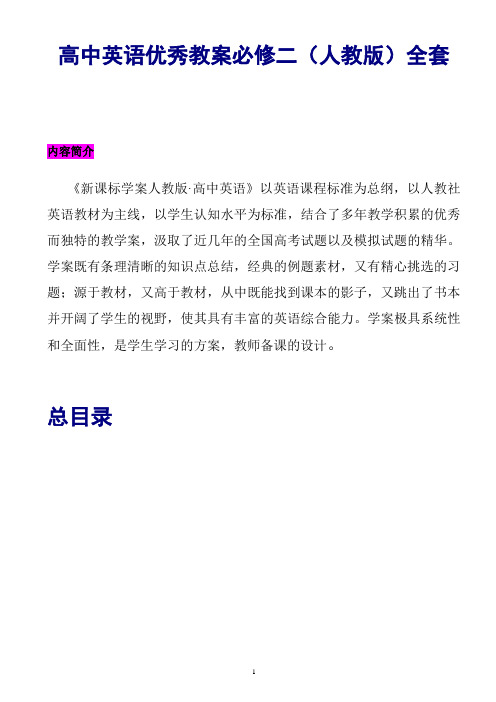
高中英语优秀教案必修二(人教版)全套内容简介《新课标学案人教版·高中英语》以英语课程标准为总纲,以人教社英语教材为主线,以学生认知水平为标准,结合了多年教学积累的优秀而独特的教学案,汲取了近几年的全国高考试题以及模拟试题的精华。
学案既有条理清晰的知识点总结,经典的例题素材,又有精心挑选的习题;源于教材,又高于教材,从中既能找到课本的影子,又跳出了书本并开阔了学生的视野,使其具有丰富的英语综合能力。
学案极具系统性和全面性,是学生学习的方案,教师备课的设计。
总目录Period 2 Learning about LanguageThe General Idea of This Period:This period includes revision of the text、learning about language.From this period the students will learn how to use some of the key words and expressions in the text and do some exercises for consolidation,and learn how to use the Present Perfect Passive V oice.Teaching Aims:1.Help the students to learn to use some useful words and expressions.2.Enable the students to learn how to use the present perfect passive voice.Teaching Important Point:The use of the present perfect passive voice.Teaching Difficult Points:How to master the usages of some important words and phrases and the Present Perfect Passive Voice.Teaching Methods:1.Task-based learning.2.Cooperative learning.3.Explanation and practice.Teaching Aids:1.A tape recorder.2.A multimedia.Teaching Procedures:Step 1 RevisionT:Boys and girls,in last period we learned something about the history and development of computers.Now who would like to retell the text with the help of these figures?S1:Let me try.In 1642,a calculating machine was used in France.Then in 1922,the Analytical Machine was made by Charles Babbage.It could follow instructions from cards with holes.In 1936,Alan Turing,the real father of computers,wrote a book to describe how computers could be made to work and built a “universal machine”to solve any mathematical ter,people discovered the computer had “artificial intelligence”.In the 1960s,the computer got his new transistors.Its size was totally changes at that time.And in the early 1960s,the first family of computers were connected to each other.In 1970s,computers have brought into people’s homes.Now computers have been used by billions of people to deal with information and communicate with each other around the world by the Internet.T:Congratulations!You’ve done very well.Now try to do the same to your partners,OK!Step 2 Words and ExpressionsTask 1T:Please turn to Page 19 and finish Discovering Useful Words and Expressions.At first,look at Ex.1.From the reading passage,find the words and expressions with the following meanings.Now,ten students will be asked to give the words.Who can?V olunteers!Check the answers together.Task 2.T:Well done.Now please look at Ex 2.and complete the passage with some of the words above.Pay attention to the use and the forms of those words.The possible answers:network so that went by totally truly simple-minded Anyway deal withTask 3T:Please finish Ex.3.Look at the sentences on Page 20.Tick the right word.Then some of you will be asked to read the sentences one by one.The possible answers:1.Life totally changed when I went to university.2.I was amazed to find that I won the competition to design a new computer.3.The competition was so exciting that we cheered all evening.4.I was so excited at the thought of meeting Yang Liwei that I could not sleep.5.Robots can be bought so cheaply that I gave one to each of my friends.6.It was so unlucky that you lost your watch at the concert.Task 4T:Please turn to Page 56 and let’s finish Using Words and Expressions.First look at Ex.1.Read through the words in the right-hand box e some of them to name each part of a computer in the left-hand box.We have known about computer.But who can give us the exact names?The possible answers:1.floppy disc2.hard disc3.scanner4.modem5.CD-ROM6.monitor7.keyboard8.printerTask 5T:Now please look at plete the sentences with some of the words in the right-hand box above.You can use each word only once.First do the exercise individually,and then check your answers with your partners.And last seven students will be asked to report their answers to the class.The possible answers:1.A printer is a machine for printing text or pictures onto paper,especially once connected to a computer.2.A CD-ROM or disk is the main device that a computer uses to store information.3.A monitor is used to see your data on a computer.4.A keyboard is used to put data into a computer.5.A CPU is often used to connect computers to each other through phone lines.6.Data can also be stored in a floppy disc,which is small and can be carried easily.7.A hard disc is a disc that contains computer data.It can store a large amount of data.Step 3 Grammar—The Present PerfectPassive V oiceT:Boys and girls,now please pay attention to the following sentences in the text:1.As the years have gone by,I have been made smaller and smaller.2.Since then,my family and I have been used by billions of people to deal with information and communicate with each other around the world by the Internet.3.I have truly been built to serve the human race since my birth.T:What verb tense is used in these sentences?And what verb voice is used in these sentences?Yes,the present perfect passive voice is used in these sentences.Can you tell us the structure of the present perfect passive voice?Quite right.The structure of the present perfect passive voice is “subject+have/has been done+object”.The function of present perfect passive voice is indicating verbs’the present perfect and the passive voice.OK,let’s practise the present perfect passive voice.Task 1T:Please turn to Page 20.Let’s finish Discovering useful structures.At first,look at Ex.2.According to examples,change the following sentences into the present perfect passive voice.Put the verbs into the correct form.Suggested answers:1.A new personal computer has been bought.2.Many problems have been found with our new computer.3.A PC has been built the way we wanted.4.Our computer has just joined to the Internet.5.The computer has been used every day since we bought it.6.A lot of e-mails have been written on the computer in the last year.Task 2T:Class,let’s play a game called “What has been decided”.Now,get into groups of four.Your task is to decide what things have been decided for the class.Take turns to make the ideas as interesting and lively as you like.Y ou may finish them according to EXAMPLES on Page 21,(or finish Ex.3 after class.)Then collect the ones you all like best and be prepared to tell them to the class.Suggested answers:S1:It has been decided that those who know of the computer will be asked to say something in class.S2:It has been decided that those who didn’t clean the blackboard will be asked to come into office after school.Task 3T:Now,please turn to Page 57.Finish using structures.First,look at Ex.1 and change the following sentences according to the model,and pay attention to the passive voice form.First do the exercise individually,and then checkyour answers with your partners.After that we’ll check the answers in class.Step 4 HomeworkT:OK,it’s almost time for a break.Now look at Ex.2 on Page 57.Translate the following sentences into English after class.The words and expressions in brackets may help you.Step 5 The Design of the Writing on the BlackboardUnit 3 ComputersPeriod 2The Present Perfect Passive V oice1.As the years have gone by,I have been made smaller and smaller.2.Since then,my family and I have been used by billions of people to deal with information and communicate with each other around the world by the Internet.3.I have truly been built to serve the human race since my birth.Structure:“subject+have/has been done+object”Step 6 Record after TeachingPeriod 3 Extensive ReadingThe General Idea of This Period:This period includes revision of the text,Reading and speaking on Page 22、Reading task on Page 58.In this period the students will be involved in a speaking activity about designing an android after reading the story of Andy,and learn something about the performances of a sporting robot of the 22nd century,Hua Fei in 78th Olympics and 79th Olympics,so that the students will not only improve their reading and speaking,but also their creative thinking.Teaching Aims:1.Help the students to learn about the different ways of designing the robots and give their opinions to the class.2.Enable the students to discuss to design their own robots.Talk about the different ways of designing the robots.Teaching Important and Difficult Points:How to design their own robots and report their designing to the class.Teaching Methods:1.Task-based learning.2.Cooperative learning.Teaching Aids:1.A tape recorder.2.A multimedia.Teaching Procedures:Step 1 GreetingsStep 2 Reading (1)We’ve learned a lot about computers,but can you imagine that computers could be put into androids or robots.Think of the fun you could have!Now let’s first read the passage about a robot called Andy—what it looks like and what it can do on Page 22,and then we’ll have a designing competition to see who will design the best robots.The students read the passage for several minutes.T:A few simple questions for you.What does Andy look like?What can it do?S2:Andy looks like a human.It is designed to play football games and can move and think like a human.Andy is really smart.T:I agree with you.Are you eager to design your smart robots?Now in small groups discuss how to design your own androids,draw a picture of your androids and write down your design.You may refer to the following questions:1.What would you like it to look like?2.What are some of the things you would like it to do?3.Do you want it to be like a man or a woman or neither?4.How much would it cost?T:And don’t forget to use the following expressions in your discussion.I think thatIn my opinion...What is your reason?I have decided that...After several minutes.T:Now,I’ll check your work.One from each group will show your picture of the android you have designed and tell the class your design.And we’ll see which group has designed the best android.Who would like to try first?S3:Look here.This is the picture of the robot we’ve designed.What does it look like?Yes,it looks like a dog.We all like dogs very much.Every morning it will wake us up so that we will not be late for school.Then it will company us to school and carry our heavy bags.You know how heavy our bags are!In the evening,after a whole day’s hard work,it will play beautiful music to help us relax.Maybe it will cost at least 2000 yuan,but we don’t think it is too expensive to have such a good friend.S4:Well,we’d like to design our robot in this way.We would like it to look like the famous footballer Beckham who serves as a striker on the football team.It has the most advanced program,so it can move and think like Beckham,and of course can shoot good goals like him.We would like it to enter the next Electronic World Cup,and we are sure that it will win the cup!T:Your designs are very unusual and smart.I really want to go on appreciating your designs,but time is limited.Will you put up your pictures of the robots you have designed with instructions on the back wall,and then decide which group has designed the best androids after comparison?Step 3 Reading (2)Class,let’s come to the Reading Task on Page 58.First read the passage quickly and then fill in the chart of Exercise 1 and keep a record of his performances of the sporting robot of the 22nd century,Hua Fei in 78th Olympics and 79th Olympics.After doing it individually,please check your answers with your partners,and then we will check the answers in class.T:It’s almost time for a break.Now homework for you today.pare the designs of the androids of each group and try to decide which one is the best.2.Suppose you have been lucky enough to be allowed to interview Hua Fei in hospital for your school paper.Work out some questions together with your partner,and then interview each other.Step 5 The Design of the Writing on the BlackboardUnit 3 ComputersPeriod 3Step 6 Record after TeachingPeriod 4 ListeningThe General Idea of This Period:This period includes listening and writing on Page 21;listening on Page 55 and listening task on Page 58.Apparently,the purpose of this period is to train the students’ listening—for information;for comprehension and for language.Meanwhile,the students will be trained to express their own opinions after listening.Teaching Aims:1.Help the students to learn about the knowledge of information technology.2.Enable the students to get the main ideas of the listening materials.Teaching Important and Difficult Points:1.How to get the main idea and information in details.2.Express their own opinions after listening.Teaching Methods:1.Task-based learning.2.Cooperative learning.Teaching Aids:1.A tape recorder.2.A multimedia.Teaching Procedures:Step 1 RevisionCheck the students’ interviews.Get the students to work together with their partners to interview each other.Step 2 Listening and writing (Page 21)Task 1 Listen to a conversationT:Class,as we all know,the 21st century is the century of information and technology.Next we will listen to a conversation about different kinds of information technology or IT.And as we know,each kind of information technology has its own advantages and disadvantages.So from this conversation we will listen for the advantages and disadvantages of each one.But before listening let’s first look at the pictures on Page 21 and the form on Page 22 to make sure what you are going to do while listening.OK,let’s begin.The students listen to the conversation for the first time.Task 2 Discussion and fillingT:You can see there are a TV,a CD-ROM,a computer,a radio,a DVD and newspaper here.Now try to finish filling in the form with the information you have just got from the conversation.T:Now,let’s discuss the advantages and disadvantages of each type of IT in small groups and then decide which type of IT is best for you to use,according to the form above and explain the reasons.While discussing,remember to use the following expressions:I think that...In my opinion...I believe that...I agree because...I disagree because...I’ve decided that...Step 3 Listening (Page 55)T:Now come to the listening on Page 55.Before you listening,please read the requirements of Ex.1.After that,you will find the three robots from the pictures above on Page 55 and number them.The possible number:Picture 1—No.3 Picture 3—No.2 Picture 4—No.1T:Now please look at these boxes on Page 55 before you listen to the tape again,and try to find out the listening points.Pay more attention to these points and you may make some notes while listening.Three minutes later.T:Now try to fill in the boxes with the information from the listening material,and then check your answers with your partners.Step 4 Listening task (Page 58)T:Now please turn to Page 58,and finish the listening task.As we know,computers are used widely and put into androids.Please look at the pictures above.There are two androids in it.One works as a maid.The other works in a car factory.They are friends and they were made at the same time.Now they are talking about their lives and what it feels like to be android.OK,please listen carefully to their problems and fill in the form.I’ll play the tape twice.After listening.T:Try to fill in the forms as quickly as you can,and then we will check the answers in class.T:From what we have just listened,we know that Sally and Brenda have some troubles in their lives.They are treated badly.Now you are going to make a list of the rights that androids should have so that they will be treated better.You can work with your partners and have discussion.Suggested answers:1.They should be able to choose the work they do.2.They should have their own time.3.They should be able to change their jobs.4.They should be able to decide their own future.5.They should be able to taste,smell,feel,etc.Step 5 AssignmentT:Class,I really appreciate your good performance in this listening class.I can see that your listening has greatly improved since you came to the senior school.Keep on your good work!OK,we have no time left.I’d like to assign you some homework to do.1.Go over the listening and writing on Page 21 and get ready for the writing.Step 6 The Design of the Writing on the BlackboardUnit 3 ComputersPeriod 4Step 7 Record after TeachingPeriod 5 WritingThe General Idea of This Period:This period includes speaking and writing on Page 22 and writing on Page 23.The purpose is to encourage the Ss to think and talk creatively about computers and androids,express their own opinions using words and expressions concerning computers and androids,and organize their ideas into a composition.Teaching Aims:1.Enable the students to learn how to write a report about their choice.2.Enable the students to learn the writing way of expressing ideas and giving reasons to support the ideas.Teaching Important and Difficult Point:How to make a decision about which kind of computer to buy and explain why.Teaching Methods:1.Task-based learning.2.Cooperative learning.Teaching Aids:A projector and multimedia.Teaching Procedures:Step 1 Speaking and writing (Page 22)T:Class,suppose you and your partner have been asked to help choose computers for your school.You have looked at several computers.Talk about the special things each computer has.Make a decision about which kind of computer to buy and explain why.And then you are going to write a report about your choice There is a list of things your computer could have.A fast PC the monitor is smallerImproved disc storage used recycled materialsInternet a flat screenStudents talk about the special things each computer can do.T:So much for the talking.And now you will be given five minutes to write a report about your choice.After that some of you will be asked to present your report to the class.In your writing try to use the present perfect passive in your report.You may begin your report like this:We looked at many different computers.The one we have chosen is the PEP personal computer.One of the main reasons is that it is suitable for schools.We found out that...Five minutes later,several students begin to present their reports to the class,and the teacher will show two or three reports using the projector to find out and correct the possible mistakes with the class.Possible versionWe looked at many different computers.The one we have chosen is the PEP personal computer.One of the main reasons is that it is suitable for schools.We found out that it looked not only cute but also advanced.First,it has a flat screen which makes the computer pretty attractive.But the second and the most important aspect about the PEP is that it has undergone a lot of improvements in many respects.For example,it contains improved disc storage and that means it’s faster PC.It’s suitable to be connected to the Internet.Also the PC has a smaller monitor and is made with used recycled materials which do no harm to the environment.In a word,we think it is suitable for our school.T:Thank you for helping choose computers which are suitable for our school,and I’m sure with these computers to be equipped in our school we will improve the teaching conditions and teaching quality of course.Now,let’s come to the writing on Page 23.Step 2 Writing(Page 23)T:Boys and girls,suppose you are an android and work for a family with one child who is very spoiled.The parents want you to do everything for them.The parents are kind,but they often ask you to watch over their child.How do you feel?What would you do if the child asked you to do his/her homework for him/her?Would you tell the child “no”?You may begin like this:Hello,everyone.My name is______.I’m a 321 model android.I work for the Li family...Now,you will also be given five minutes to write your opinion and feelings.Five minutes later,the teacher shows two or three of the passages written by the students using the projector to find out and correct the possible mistakes with the class.Possible versionHello,everyone.My name is ______.I’m a 321 model android.I work for the Li family.My job is taking care of their only son.The parents are nice but the boy is spoiled.The family asked me to do everything for them,from shopping to cleaning the floors.But what’s terrible,the child asked me to do his homework!That’s too much!I’m an android,yes,but I’ve got my mind and feelings I can’t do things that are harmful to people against my will!Step 3 Summary and HomeworkT:Boys and girls,in this period,we worked hard and wrote two short compositions.You’ve not only learned tomake your choices or express your ideas but also learned to give your reasons to support your choices or ideas.It’s really a practical writing job for you to do,don’t you think so?Such writing jobs,I’m sure,will help you improve your writing skills.Now homework for you today—go over the whole unit.Step 4 The Design of the Writing on the BlackboardUnit 3 ComputersPeriod 5A fast PC the monitor is smallerImproved disc storage used recycled materialsInternet a flat screenStep 5 Record after TeachingPeriod 6 AssessmentThe General Idea of This Period:This period is to help the Ss to elevate their acquisition aboutcomputers androids and IT and their ability of employing the words,expressions,grammar learned in this unit.Teaching Aims:1.Elevate efficiently the students’ knowledge about computers,androids and IT.2.Elevate the Ss ability of using the words and expressions and grammar learned in this unit.Teaching Important and Difficult Point:Help the Ss learn to assess whether their knowledge about this topic has increased.Teaching Methods:1.Question-and-answer activity.2.Pair work and group work to make the students work in class.Teaching Aids:1.A multimedia.2.A blackboard.Teaching Procedures:Step 1 GreetingsT:Good morning,boys and girls.Ss:Good morning,Miss.Step 2 RevisionT:So far we have finished this unit which is about...?Ss:It’s about the history and development of computers.S1:I have learned tremendous about the computers,androids and I’ve made up my mind to learn computer science in the future if possible.T:Terrific.Step 3 AssessmentT:Today we are going to see how hard you worked and how much more you know about computers.Now work with your partners and finish these questions first.非测试性评价1.To what extent are computer and Internet becoming part of your life?I use the computer and/or Internet to:—type my homework—draw pictures—play games—communicate with my friends—gather related information for my lessons.—buy the things I like,eg:books and clothes.—listen to music—watch movies.2.What else do you think the computer and Internet will help you to do?_______________________________________________3.Which part(s)of the computer do you think need(s)more improvement?Why?You can use Exercise 1 in the workbook(P56)as reference for the parts of the computer._______________________________________________4.Look at the flow chart explaining how the computer technology has been developing and complete it with your partners.Then give a brief oral presentation on the development of computer technology with the help of the chart.When you’re preparing it,you can refer to the reading passage on Page 18 of the Student’s Book.Your oral presentation will be less than three minutes.测试性评价Ⅰ.单词拼写1.In c with most educated people,he prefers classical music to jazz.2.The invention of computer was a ______(技术的)revolution.3.He is quite clever a boy though he looks s -minded.4.In the past 20 years,my hometown has t changed.puters are often used to deal with information and communicate with each other around the world by theI .6.There are many ways of ______(通讯)in the modern world,such as telephone,fax,and so on.7.In the early 1960s,computers were connected by a n ,so that people could share information and talk to each other.8.He is so clever that he is considered to have high ______(智力).9.She was ______(徘徊)up and down the road,not knowing what to and where to go.10.Could you tell me the advantages and d of being famous?Possible answers:mon 2.technological 3.simple 4.totally 5.Internet munication work 8.intell-igence 9.wandering 10.disadvantagesⅡ.句型转换/完成句子1.Personally,I think the team who won first place cheated.______ ______ ______,I think the team who won first place cheated.2.I’m afraid something urgent has risen;I won’t be able to see you tonight.I’m afraid something urgent has ______ ______;I won’t be able to see you tonight.3.As time ______ ______(流逝),my memory seems to get worse.4.They’ve bought many books which are ______ ______(适合)teenagers.5.The new type of mobile phone is expensive.______,it’s worth buying it.6.He was foolish enough to accept her invitation.He was ______ foolish ______ he accepted her invitation.7.How are you going to ______ ______(处理)the water pollution of the area?8.You have to ______ ______ ______(做出决定)whether to accept the job or not.Possible answers:1.In my opinion e up 3.goes by 4.suitable for 5.Anyway/Anyhow 6.so,that 7.deal with 8.make a choiceStep 4 The Design of the Writing on the BlackboardUnit 3 ComputersPeriod 6In my opinion so...thatcome up deal+withgoes by make a choicesuitable...forStep 5 Record after TeachingActivities and Research:Whether or not should the computer be used in teaching?Suppose your classroom has been equipped with a computer.Your teachers have used a lot the computer in their teaching.Some of your classmates are for using the computer in teaching,but the others are against using the computer in teaching,and you try to work in two sides:1.Bring this topic to your classmates,and divide the class into two sides,each of which has several small groups.2.Make a list of the advantages/disadvantages about using the computer in teaching based on the opinions or ideas of those who are for/against using the computer in teaching.3.Share your list with other groups,put your lists together to make one comprehensive list out of what each groups has come up.4.You may also want to read and surf the Internet about different views on using the computer in teaching to find more reasons to support your ideas.5.Then,come to a reasonable decision about whether or not the computer should be used in teaching.6.Create a debate in class on whether or not the computer should be used in teaching.7.While debating,you will try to use the following expressions.I think that... Yes,I think so. I don’t think so. I agree that... I don’t agree. I’m afraid not. In my opinion,In addition,Besides,First...,second...,In a word/In briefPeriod 2 Learning about LanguageThe General Idea of This Period:This period will consolidate the words and expressions the students learnt in the reading part and deal with the grammar part:the Present Progressive Passive V oice.You will have systematic explanations of it and assign some exercises for the students to complete to consolidate what you learn.Teaching Aims:1.Help the students recognize the useful words and expressions learnt in Reading part:apply for,bite,have an effort on (=affect),quality,as a result,powerless.。
新课标人教版高中英语必修二精品教案
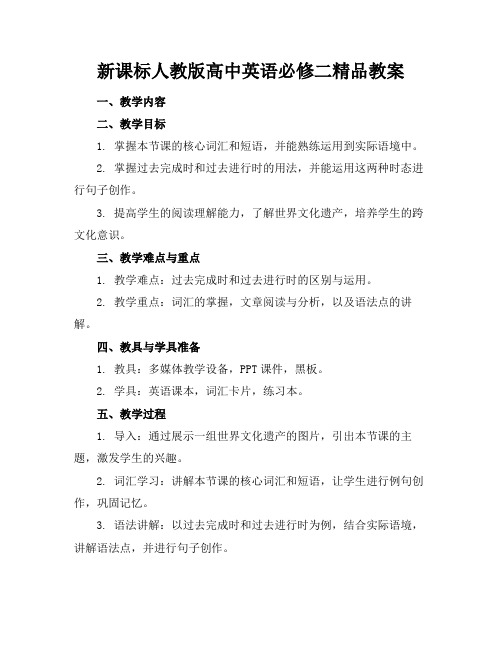
新课标人教版高中英语必修二精品教案一、教学内容二、教学目标1. 掌握本节课的核心词汇和短语,并能熟练运用到实际语境中。
2. 掌握过去完成时和过去进行时的用法,并能运用这两种时态进行句子创作。
3. 提高学生的阅读理解能力,了解世界文化遗产,培养学生的跨文化意识。
三、教学难点与重点1. 教学难点:过去完成时和过去进行时的区别与运用。
2. 教学重点:词汇的掌握,文章阅读与分析,以及语法点的讲解。
四、教具与学具准备1. 教具:多媒体教学设备,PPT课件,黑板。
2. 学具:英语课本,词汇卡片,练习本。
五、教学过程1. 导入:通过展示一组世界文化遗产的图片,引出本节课的主题,激发学生的兴趣。
2. 词汇学习:讲解本节课的核心词汇和短语,让学生进行例句创作,巩固记忆。
3. 语法讲解:以过去完成时和过去进行时为例,结合实际语境,讲解语法点,并进行句子创作。
4. 阅读理解:让学生阅读课文,回答相关问题,提高阅读理解能力。
5. 随堂练习:设计相关练习题,检验学生对词汇、语法和阅读理解的学习效果。
6. 小组讨论:分组讨论文化遗产的保护与传承,培养学生的跨文化意识。
六、板书设计1. 核心词汇和短语。
2. 过去完成时和过去进行时的语法点。
3. 课文结构及重点句子。
七、作业设计1. 作业题目:根据课文内容,写一篇关于文化遗产保护的短文。
Cultural heritage protection is of great importance. The Amber Room, a masterpiece of art, was once lost but has now been recovered. In order to protect our cultural heritage, we should take measures to preserve and pass on these invaluable treasures.八、课后反思及拓展延伸1. 反思:关注学生在课堂上的表现,了解他们的学习需求,不断调整教学方法,提高教学效果。
新人教版高中英语必修二教案(全册)
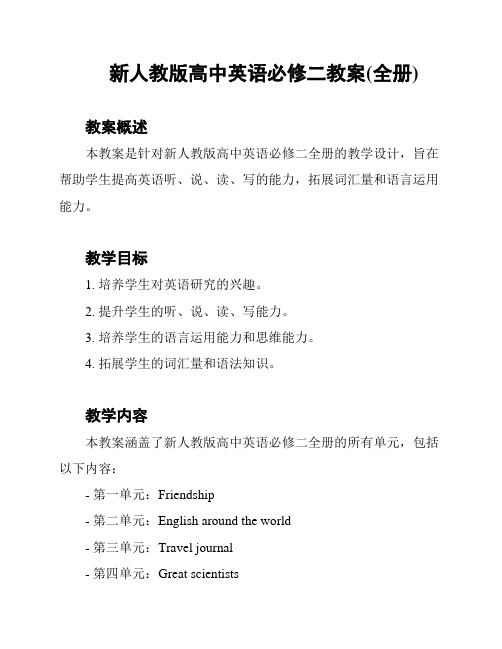
新人教版高中英语必修二教案(全册)教案概述本教案是针对新人教版高中英语必修二全册的教学设计,旨在帮助学生提高英语听、说、读、写的能力,拓展词汇量和语言运用能力。
教学目标1. 培养学生对英语研究的兴趣。
2. 提升学生的听、说、读、写能力。
3. 培养学生的语言运用能力和思维能力。
4. 拓展学生的词汇量和语法知识。
教学内容本教案涵盖了新人教版高中英语必修二全册的所有单元,包括以下内容:- 第一单元:Friendship- 第二单元:English around the world- 第三单元:Travel journal- 第四单元:Great scientists- 第五单元:Global warming- 第六单元:Science and technology- 第七单元:Cultural relics- 第八单元:Art and artists- 第九单元:Media教学方法1. 情境教学:通过创设各种真实的语言环境,培养学生的语言运用能力。
2. 交际教学:通过各种实际的交际活动,提高学生的口语表达和交流能力。
3. 阅读教学:通过各类文本的阅读,培养学生的阅读理解能力和批判性思维。
4. 写作教学:通过不同类型的写作训练,提高学生的写作能力和创造力。
教学活动1. 课堂听说练:通过听力材料和口语练,帮助学生提高听说能力。
2. 阅读理解练:通过阅读文章和解答问题,培养学生的阅读理解能力。
3. 交流讨论活动:组织学生进行各类交际和讨论活动,提高学生的口语交际能力。
4. 文字表达训练:通过写作练,帮助学生提高写作能力。
教学评价1. 课堂表现评价:根据学生的课堂听说读写能力和参与度进行评估。
2. 作业评价:根据学生的作业完成情况和写作质量进行评估。
3. 测试评价:定期进行听力、口语、阅读和写作的测试,评估学生的综合能力。
教学资源1. 教材:“新人教版高中英语必修二”教材。
2. 多媒体设备:投影仪、音响等。
3. 教学文具:笔、纸、课本等。
最新人教版高中英语必修二教案(全册_共139页)
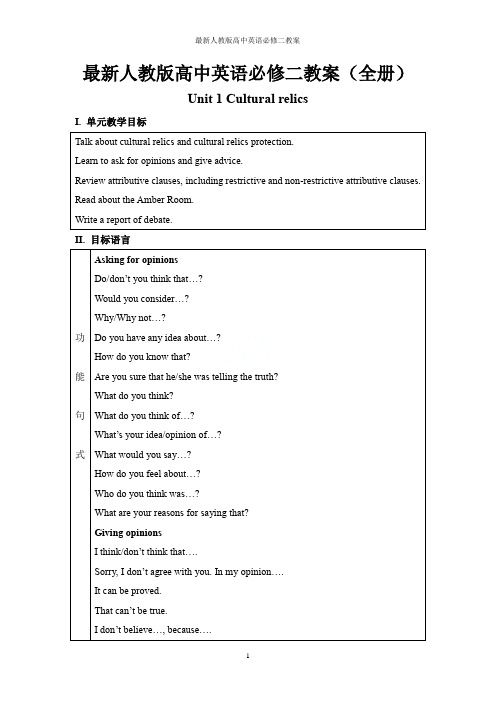
最新人教版高中英语必修二教案最新人教版高中英语必修二教案(全册)Unit 1 Cultural relicsI. 单元教学目标II. 目标语言II. 教材分析与教材重组1. 教材分析本单元以cultural relics为话题,旨在通过单元教学使学生了解世界文化遗产,学会描述它们的起源,发展和保护等方面的情况,复习并掌握定语从句,能就如何保护和处理世界文化遗产给出自己的观点。
1.1 Warming up热身部分提供了四幅图片,设计了三个问题让学生交流对于cultural relic的了解,并就此进行讨论。
这部分的目的是呈现本单元的中心话题“文化遗产”。
1.2 Pre-reading是Reading的热身部分,提供了ambers的图片并就此此设计了两个问题。
这两个问题极易引起学生对amber的兴趣,并能引导学生对课文进行prediction。
1.3 Reading是关于寻找丢失了的普鲁士国王威廉一世送给俄罗斯沙皇的那个琥珀房子的建立、转让、被毁、重建的整个历史。
设计这篇文章的目的是让学生了解什么是文化遗产以及讨论保护和重建文化从文化遗产的重要性和必要性。
1.4 Comprehending既有知识性的问题,同时又跳出了课文,对文章进行整体评价,由易到难,有较好的梯度,全面考查学生对文章的理解。
Exercise 1将人物及相关事件匹配,检验学生对文章细节的理解;Exercise 2 将所给的问题与段落匹配,是段落大意理解题;Exercise 3安排了对于重建lost cultural relics的意义进行讨论,使得学生能对本单元的主题进行较为深入的探讨。
1.5 Learning about language 分Discovering useful words and expressions 和Discovering useful structures两部分。
其中第一部分的Exercise 1着重训练对英语单词解释的理解。
新课标人教版高中英语必修二教案

新课标人教版高中英语必修二教案一、教学内容本节课选自新课标人教版高中英语必修二,内容包括第三章“Computers”的13节。
详细内容主要围绕计算机的基本组成、功能以及与人们生活的关系进行讲解。
二、教学目标1. 了解计算机的基本组成和功能,能运用所学知识进行简单的计算机操作。
2. 提高学生的英语阅读理解能力,培养他们获取、筛选信息的能力。
3. 增强学生的跨文化交际意识,使他们能够用英语介绍我国计算机技术的发展。
三、教学难点与重点教学难点:计算机专业词汇的理解与运用。
教学重点:计算机的基本组成、功能以及与人们生活的关系。
四、教具与学具准备教具:多媒体教学设备、PPT课件、黑板、粉笔。
学具:英语课本、笔记本、文具。
五、教学过程1. 导入:通过展示生活中常见的计算机设备,引导学生思考计算机在生活中的作用,激发学生的学习兴趣。
2. 新课内容呈现:(1)展示计算机发展历程的图片,引导学生了解计算机的演变。
(2)讲解计算机的基本组成和功能,让学生掌握相关词汇和知识点。
3. 例题讲解:讲解教材中的例题,引导学生运用所学知识解决问题。
4. 随堂练习:设计练习题,让学生巩固所学知识。
5. 小组讨论:让学生分组讨论计算机在生活中的应用,提高他们的跨文化交际意识。
六、板书设计1. Computers2. 内容:(2)Computer functions: input, process, output, storage七、作业设计1. 作业题目:(1)Translate the following sentences into English:计算机由哪些部分组成?计算机有哪些功能?2. 答案:八、课后反思及拓展延伸1. 课后反思:教师反思本节课的教学效果,针对学生的反馈进行教学调整。
2. 拓展延伸:鼓励学生利用课余时间了解计算机的更多知识,如计算机编程、网络技术等,提高他们的综合素质。
重点和难点解析1. 教学内容的针对性:如何围绕计算机的基本组成、功能以及与人们生活的关系进行讲解。
人教版高中英语必修二教案
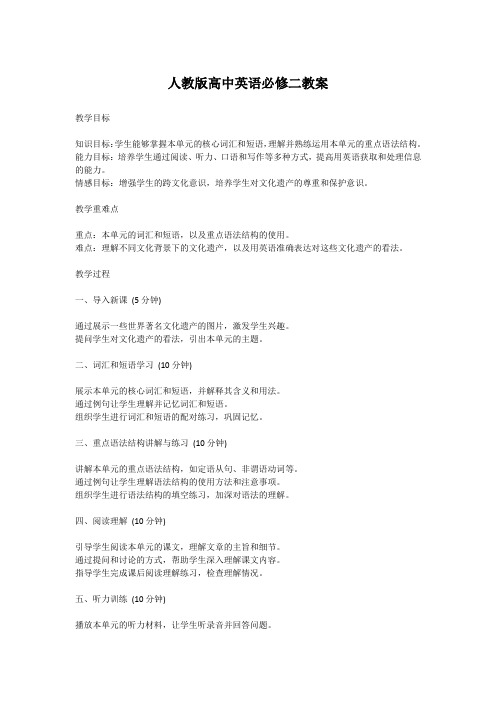
人教版高中英语必修二教案教学目标知识目标:学生能够掌握本单元的核心词汇和短语,理解并熟练运用本单元的重点语法结构。
能力目标:培养学生通过阅读、听力、口语和写作等多种方式,提高用英语获取和处理信息的能力。
情感目标:增强学生的跨文化意识,培养学生对文化遗产的尊重和保护意识。
教学重难点重点:本单元的词汇和短语,以及重点语法结构的使用。
难点:理解不同文化背景下的文化遗产,以及用英语准确表达对这些文化遗产的看法。
教学过程一、导入新课(5分钟)通过展示一些世界著名文化遗产的图片,激发学生兴趣。
提问学生对文化遗产的看法,引出本单元的主题。
二、词汇和短语学习(10分钟)展示本单元的核心词汇和短语,并解释其含义和用法。
通过例句让学生理解并记忆词汇和短语。
组织学生进行词汇和短语的配对练习,巩固记忆。
三、重点语法结构讲解与练习(10分钟)讲解本单元的重点语法结构,如定语从句、非谓语动词等。
通过例句让学生理解语法结构的使用方法和注意事项。
组织学生进行语法结构的填空练习,加深对语法的理解。
四、阅读理解(10分钟)引导学生阅读本单元的课文,理解文章的主旨和细节。
通过提问和讨论的方式,帮助学生深入理解课文内容。
指导学生完成课后阅读理解练习,检查理解情况。
五、听力训练(10分钟)播放本单元的听力材料,让学生听录音并回答问题。
通过听力训练,提高学生的听力理解能力。
对学生的回答进行点评和纠正,强调听力中的重点信息。
六、口语练习(10分钟)组织学生进行小组讨论,讨论自己对文化遗产的看法和态度。
邀请几组学生上台展示讨论成果,其他学生进行评价。
教师点评学生的表现,并给出建议和指导。
七、写作训练(10分钟)布置本单元的写作任务,如写一篇关于文化遗产的文章。
指导学生如何构思文章结构、选择词汇和语法等。
学生开始写作,教师巡视指导,及时给予帮助和建议。
八、课堂小结(5分钟)总结本单元的重点内容和学习目标。
强调文化遗产的重要性,呼吁学生尊重和保护文化遗产。
新课标人教版高中英语必修二教案
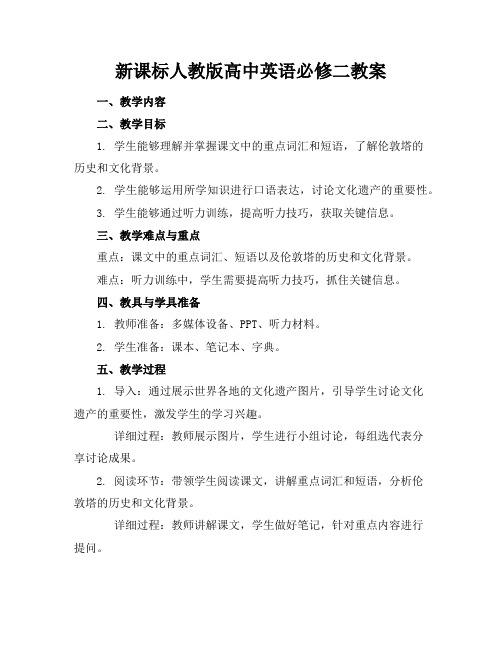
新课标人教版高中英语必修二教案一、教学内容二、教学目标1. 学生能够理解并掌握课文中的重点词汇和短语,了解伦敦塔的历史和文化背景。
2. 学生能够运用所学知识进行口语表达,讨论文化遗产的重要性。
3. 学生能够通过听力训练,提高听力技巧,获取关键信息。
三、教学难点与重点重点:课文中的重点词汇、短语以及伦敦塔的历史和文化背景。
难点:听力训练中,学生需要提高听力技巧,抓住关键信息。
四、教具与学具准备1. 教师准备:多媒体设备、PPT、听力材料。
2. 学生准备:课本、笔记本、字典。
五、教学过程1. 导入:通过展示世界各地的文化遗产图片,引导学生讨论文化遗产的重要性,激发学生的学习兴趣。
详细过程:教师展示图片,学生进行小组讨论,每组选代表分享讨论成果。
2. 阅读环节:带领学生阅读课文,讲解重点词汇和短语,分析伦敦塔的历史和文化背景。
详细过程:教师讲解课文,学生做好笔记,针对重点内容进行提问。
3. 听力环节:播放听力材料,让学生进行听力训练,提高听力技巧。
详细过程:教师播放听力材料,学生跟随材料完成练习题,教师讲解答案。
4. 口语表达:让学生结合所学内容,讨论文化遗产的保护和传承。
详细过程:教师提出讨论话题,学生进行小组讨论,每组选代表进行分享。
5. 随堂练习:完成课后练习题,巩固所学知识。
详细过程:学生独立完成练习题,教师进行讲解。
六、板书设计1. 课文The Story of the Tower of London2. 重点词汇和短语3. 伦敦塔历史和文化背景4. 听力技巧5. 口语表达话题七、作业设计1. 作业题目:结合所学内容,写一篇关于文化遗产保护的短文。
答案:学生需运用所学词汇和短语,表达对文化遗产保护的看法。
2. 课后练习题八、课后反思及拓展延伸1. 教师反思:关注学生在课堂上的表现,针对学生的掌握情况,调整教学方法和节奏。
3. 拓展延伸:鼓励学生课后了解我国的世界文化遗产,提高文化素养。
重点和难点解析1. 教学内容的选取与组织2. 教学目标的具体制定3. 教学难点与重点的明确4. 教学过程中的实践情景引入、例题讲解和随堂练习5. 板书设计的关键要素6. 作业设计的针对性与拓展性7. 课后反思与拓展延伸的实际操作一、教学内容的选取与组织1. 阅读和听力材料的选择应贴近学生生活,激发学生兴趣。
新课标高中英语必修二全册教案必修2教案

新课标高中英语必修二全册教案必修2教案介绍本教案是针对新课标高中英语必修二全册的教学内容而设计的。
必修二教案旨在帮助学生更好地理解和掌握相关的英语知识和技能。
通过本教案,学生将能够提高听、说、读、写和翻译等英语技能,同时也能够拓宽他们的英语词汇量和语法知识。
教学目标- 提高学生的听力理解能力,使其能够正确听懂和理解与课本内容相关的英语对话和文章。
- 培养学生的口语表达能力,使其能够用流利和准确的英语进行简单的对话和交流。
- 培养学生的阅读理解能力,使其能够读懂并理解课本中的英语文章和故事。
- 帮助学生提高写作能力,使其能够用英语书写简单的句子、段落和文章。
- 锻炼学生的翻译能力,使其能够将中文翻译成英文和将英文翻译成中文。
教学内容本教案涵盖了必修二全册的所有课程内容,包括但不限于以下主题:- Unit 1: Cultural Relics- Unit 2: The Olympics- Unit 3: Life in the Future- Unit 4: Earthquakes- Unit 5: Nelson Mandela- Unit 6: Life in the Future教学方法为了达到上述教学目标,我们将采用以下教学方法:- 听力训练:通过让学生听录音和对话来提高他们的听力理解能力。
- 口语练:通过角色扮演和对话活动来培养学生的口语表达能力。
- 阅读训练:通过阅读课本中的文章和故事来提高学生的阅读理解能力。
- 写作练:通过写作任务和练来帮助学生提高写作能力。
- 翻译训练:通过翻译练来锻炼学生的翻译能力。
教学评估为了评估学生的研究效果和对教学内容的掌握程度,我们将采用以下评估方式:- 听力测试:通过听力测试来评估学生的听力理解能力。
- 口语表达:通过口语表达任务和对话活动来评估学生的口语表达能力。
- 阅读理解:通过阅读理解任务和测试来评估学生的阅读理解能力。
- 写作评估:通过作文和写作练来评估学生的写作能力。
新课标人教版高中英语必修二教案(1)

新课标人教版高中英语必修二教案一、教学内容本节课选自新课标人教版高中英语必修二,主要讲解第二章"Country life and city life"的第一、二节。
内容包括乡村生活与城市生活的对比,以及与之相关的词汇、语法和表达方式。
二、教学目标1. 了解并掌握与乡村生活、城市生活相关的词汇和表达方式。
2. 运用一般现在时和一般过去时描述乡村和城市的生活。
3. 能够就乡村生活与城市生活的优缺点进行讨论,表达个人观点。
三、教学难点与重点1. 教学难点:一般过去时与一般现在时的运用,以及对乡村生活与城市生活优缺点的讨论。
2. 教学重点:与乡村生活、城市生活相关的词汇和表达方式,以及一般现在时和一般过去时的区别。
四、教具与学具准备1. 教具:多媒体设备、黑板、粉笔。
2. 学具:英语课本、笔记本、练习本。
五、教学过程1. 导入:通过展示乡村和城市的图片,引导学生谈论对两种生活的初步认识。
2. 新课内容展示:a. 讲解与乡村生活、城市生活相关的词汇和表达方式。
b. 示例:用一般现在时和一般过去时描述图片中的生活场景。
3. 例题讲解:讲解一般现在时和一般过去时的区别,并举例说明。
4. 随堂练习:让学生运用所学知识,描述自己理想中的乡村生活或城市生活。
5. 小组讨论:让学生分组讨论乡村生活与城市生活的优缺点,并派代表进行分享。
六、板书设计1. Country life and city life2. 主要内容:a. 乡村生活、城市生活相关词汇和表达方式。
b. 一般现在时与一般过去时的区别。
c. 乡村生活与城市生活的优缺点。
七、作业设计1. 作业题目:Write an essay about your ideal country life or city life, using the vocabulary and expressions learned in class. (不少于100词)2. 答案示例:I prefer country life because it is peaceful and close to nature. In the countryside, I can enjoy fresh air, beautiful scenery and friendly neighbors. Unlike city life, which is always crowded and noisy, country life allows me tolive a slowerpaced life. I think the advantages of country life outweigh its disadvantages.八、课后反思及拓展延伸1. 课后反思:关注学生在课堂上的参与度,以及对词汇和语法知识的掌握程度,及时调整教学方法。
人教版新课标高中英语必修2全套教案
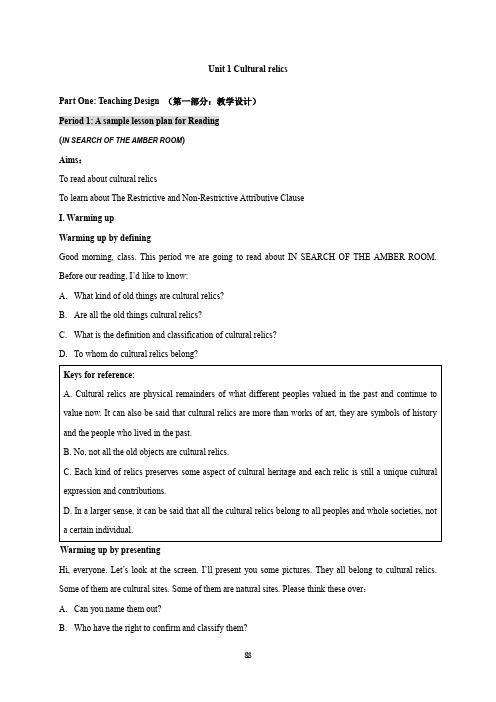
Unit 1 Cultural relicsPart One: Teaching Design (第一部分:教学设计)Period 1: A sample lesson plan for Reading(IN SEARCH OF THE AMBER ROOM)Aims:To read about cultural relicsTo learn about The Restrictive and Non-Restrictive Attributive ClauseI. Warming upWarming up by definingGood morning, class. This period we are going to read about IN SEARCH OF THE AMBER ROOM. Before our reading, I’d like to know:A.What kind of old things are cultural relics?B.Are all the old things cultural relics?C.What is the definition and classification of cultural relics?D.To whom do cultural relics belong?Warming up by presentingHi, everyone. Let’s look at the screen. I’ll present you some pictures. They all belong to cultural relics. Some of them are cultural sites. Some of them are natural sites. Please think these over:A.Can you name them out?B.Who have the right to confirm and classify them?Warming up by discussingNow, boys and girls, I met a “moral dilemma”. That means I must make a choice between the interests of the family and the interests of the society. Things are like this: My old granny happened to find an ancient vase under the tree in the earth of our garden. It’s so beautiful and special. Now, my family fell into a moral dilemma. Can you help us to make a decision:A: What should we do?B: Can we keep it for ourselves or report it to the government?C: Have you come across such a situation —to make a difficult choice?II. Pre-reading1. Looking and sayingWork in pairs. Look at the photos on the screen. All these relics are quite beautiful. But some of them were lost and ruined in history,such as Yuan MingYuan and the Amber Room. Please guess:A.What kinds of things can result in their disappearing?B.Why do they come into being once again?2. Explaining and sharingWork in groups of four. Tell your group mates:A.What do you know about the substance of “amber”?B.What do you know about the cultural relics “the Amber Room”?III. Reading1. Reading aloud to the recordingNow please listen and read aloud to the recording of the text IN SEARCH OF THE AMBER ROOM. Pay attention to the pronunciation of each word and the pauses within each sentence. I will play the tape twice and you shall read aloud twice, too.2. Skimming and identifying the general idea of each paragraphNow please skim the text to get the key words and general idea of each paragraph.3.Scanning and analyzing the characteristics of the text.Since you have got to know the general ideas of each paragraph, can you tell me the characteristics of the passage, such as, the type of writing, the way of narrating, and the tense?4.Reading and understandingNext you are to read and underline all the useful expressions or collocations in the passage. Copy them to your notebook after class as homework.5. Reading and transferring informationRead the text again to complete the table, which lists all the numbers in the text.6.Reading and learningRead the text and learn more about the following proper nouns. You can surf on the website after class:ⅣClosing downClosing down by doing exercisesTo end the lesson you are to do the comprehending exercises No. 1 and No. 2.Closing down by having a discussionA.Can you imagine the fate of the Amber Room? What is it?B.Do you think if it is worthwhile to reproduce the Amber Room? Why?Closing down by retelling the story of the Amber RoomWell, all of us have learned the history of the Amber Room. Let’s recall some key words and expressions on the board. You are to retell the story of the Amber Room:Period 2: A lesson plan for Learning about Language(The Restrictive and Non-Restrictive Attributive Clause)Aims:To learn about the restrictive and non-restrictive attributive clauseTo discover some useful words and expressionsTo discover some useful structuresProcedures:I. Warming upWarming up by discovering useful words and expressionsPlease turn to page 3. Do exercises 1, 2, 3 and 4 first. Please check your answers against your classmates’. Warming up by explainingNow, class, since you’ve read the passage, could you explain to me how to use the phrase “belong to”? The word “to” here is a preposition, indicating the possession, and is always followed by nouns or pronoun. Look at Ex 3. The preposition “at” indicates a state, condition or continuous activity. So we can replace them or express them by using a present-continuous tense.II. Learning about Attributive Clause1. What is an adjective Clause?An adjective clause is a dependent clause which takes the place of an adjective in another clause or phrase. Like an adjectiv e, an adjective clause modifies a noun or pronoun, answering questions like “which?” or “what kind of?” Consider the following examples:Adjectivethe red coatAdjective clausethe coat which I bought yesterdayLike the word “red” in the first example,the dependent clause “which I bought yesterday” in the second example modifies the noun “coat.” Note that an adjective clause usually comes after what it modifies, while an adjective usually comes before.In formal writing, an adjective clause begins with the relative pronouns “who(m),” “that,” or “which.” In informal writing or speech, you may leave out the relative pronoun when it is not the subject of the adjective clause, but you should usually include the relative pronoun in formal, academic writing: informalThe books people read were mainly religious.formalThe books that people read were mainly religious.informalSome firefighters never meet the people they save.formalSome firefighters never meet the people whom they save.Here are some more examples of adjective clauses:the meat which they ate was taintedThis clause modifies the noun “meat” and answers the question “which meat?”.They’re talking about the movie which made him cryThis clause modifies the noun “movie” and answers the question “which movie?”.They are searching for the student who borrowed the bookThe clause modifies the pronoun “student” and answers the question “which student?”.Did I tell you about the author whom I met?The clause modifies the noun “author” and answers the question “which author?”.2. Restrictive & non restrictive clausesDo the following pairs of sentences mean the same thing?1a My uncle, who lives in London, is very rich.2b My uncle who lives in London is very rich.2a The policies, which were unpopular, were rejected by the voters.2b The policies which were unpopular were rejected by the voters.3a My niece, whose husband is out of work, will inherit the house, which I have always treasured.3b My niece whose husband is out of work will inherit the house which I have always treasured.The first sentence in each pair has a non-restrictive clause within two commas, and the second has a restrictive clause. A non-restrictive clause simply adds more information into the sentence and does not affect the meaning of the main clause: it is therefore bracketed off with commas (1a = an uncle who happens to live in London). Conversely, a restrictive clause defines its referent in the main clause more specifically and contributes significantly to the meaning of the sentence. Thus it is that particular uncle who lives in London who is referred to (1b). In 2a, all policies were unpopular and all were rejected, whereas in 2b only the policies that were unpopular were rejected. Note that in restrictive clauses the non-human relative pronoun is either ‘that’ or ‘which’, whereas for human referents the relative pronoun can be either ‘who/m’ or ‘that’ (the man that/whom I will marry ....).3. A test on FORMAL ADJECTIVE CLAUSESDirections: Combine the sentences. Use formal written English.Use (b) as an adjective clause. Punctuate carefully.1) (a) An antecedent is a word. (b) A pronoun refers to this word.An antecedent ____2) (a) The blue whale is considered the largest animal that has ever lived.(b) It can grow to 100 feet and 150 tons.The blue whale ____3) (a) The plane was met by a crowd of 300. (b) Some of them had been waiting for more than 4 hours. The plane ____4) (a) In this paper, I will describe the basic process.(b) Raw cotton becomes cotton thread by this process. In this paper, I will describe ____5) (a) The researchers are doing case studies of people to determine the importance of heredity in health and longevity.(b) These people’s families have a history of high blood pressure and hea rt disease.The researchers are doing case studies ____6) (a) At the end of this month, scientists at the institute will conduct their AIDS research. (b) The results of this research will be published within 6 months.At the end of this month, scientists ____7) (a) According to many education officials, ‘math phobia’(that is, a fear of mathematics) is a widespread problem. (b) A solution to this problem must and can be found.According to many education officials, ‘math phobia’ ____8) (a) The art museum hopes to hire a new administrator.(b) Under this person’s direction it will be able to purchase significant pieces of art.The art museum ____9) (a) The giant anteater licks up ants for its dinner.(b) Its tongue is longer than 30 centimeters (12 inches).The giant anteater ____10) (a) The anteater’s tongue is sticky.(b) It can go in and out of its mouth 160 times a minute.The anteater’s tongue ____III. Closing down by taking a quizQuiz on Attributive clauseSelect one answer from the choices provided after each sentence. The words you choose should fit the blank in the sentence. Don’t use the HINT buttons unless you really need them.1. As many children came were given some cakes.A. thatB. asC. whoD. whom2. The visitors saw rows of houses the roofs are red.A. on whichB. of whichC. whereD. that3. I usually take a nap after lunch, is my habit.A. which itB. as itC. asD. that4. Please tell me the way you did the job.A. howB. whereC. whichD. in which5 Is this museum some German friends visited the day before yesterday?A. the oneB. whichC. thatD. where6. The farmer uses wood to build a house to store grain.A. in whichB. whereC. thatD. with which7. I shall never forget the years I spent in the country with the farmers, has a great effect onmy life.A. when, whichB. that, whichC. when, thatD. which, that8. Little has been done is helpful to our work.A. thatB. whatC. whichD. all that9. Perhaps this is the only market you can get such cheap goods.A. thatB. of whichC. by whichD. where10. We’ll put off the outing until next week, __ we won’t be so busy.A. whenB. whichC. at whichD. in thatKey: 1~10:BBCDA ABADAPeriod 3: A lesson plan for using languageAims:To learn to tell facts from opinionsTo write a reply letterTo listen and speak about cultural relicsProceduresI. Warming upWarming up by questionsMorning, class. We always say, “We must respect facts and can’t wholly depend on one’s opinions”. But can you tell me:A.What does it mean when you say, “I t is a fact”?B.What does it mean when you say, “I t is an opinion”?Warming up by questioningTurn to page 5. Read the passage and tell me:A.If you want to go in for law against somebody, and if you want to win, what’s the most important thingyou should do first?B.What makes a judge decide which eyewitnesses to believe and which not to believe.II. Guided reading1.Reading and definingRead the passage and define: What is a fact? What is an opinion? What is an evidence?2. Reading and translatingRead the passage and translate it into Chinese paragraph by paragraph. Tom, you are to do paragraph 1, please…3. Reading and underliningNext you are to read and underline all the useful expressions or collocations in the part. Copy them to your notebook after class as homework.4. ListeningNow, boys and girls, as we know, people have never stopped searching for the Amber Room. This time we’ll listen to what three people say they know about the missing Amber Room. Before we listen to them, I’ll present some related new words to you to help you understand them easily. Please look at the screen and read after me.5. Sharing and CorrectingWell done. Now share your forms with your partner and tell me in the three forms: What are facts? What are opinions? Li Ming, do you want a try?6. ReviewingWe often use some expressions to ask for opinions. What are they?Oh, yes. What do you think of …?Do you believe …?How can you be sure of …?How do you know that?And we often use some expressions to give opinions. What are they? Ok, Tom, Please. Oh, yes. They are: I think…/ I don’t think…I don’t agree that…/ I suppose that…7. DiscussingPlease look at exercise 3, and discuss which person gave the best evidence. Use the expressions above to help you. Before we discuss, let’s deal with the following discussion:A.What is the best evidence?B.How can we know which eyewitness is most believable?Well done. Let’s come to the discussion “Which person gave the best evidence?”8. Reading and writingSometimes we may fall into or face a moral choice. That is a moral dilemma. Let’s read the letter on page 7 and see what’s Johann’s choice and opinion. Ok, finished? Now answer the following questions:A.What’s Johann’s opinion about the Amber Room?B.What’s his father’s opinion about the things found by him?C.What happened to Johann when she was a pupil?9. Completing the letters A & B and then giving your own letters·When you write your letter, you may choose to agree or not agree with the writer.·You must give a reason why you agree or don’t agree with the writer.·Be sure to give an example from your own life so that the reader can better understand your opinion. ⅢClosing downClosing down by a debatingThere is a long ancient wall around a less developed town.It is reported it has a long history, dating back to over 5 century BC. The local government is collecting money to repair and rebuild the wall. It has cost a lot of money. Some of your classmates think it is not worth. Some think it’s a good way to develop the local economy. Now Group 1 and 2 against Group 3 and 4. Let’s have the debating.Closing down by dictation·The design for the room was of the fancy style popular in those days.·The room served as a small reception hall for important visitors.·The man who found the relics insist that it belongs to his family.·The room was completed the way she wanted it .·It was ready for the people of St. Petersburg to celebrate the 300th birthday of their city.·After that, what really happened to the Amber Room remains a mystery.·In a trial, a judge must decide which eyewitnesses to believe and which not to believe.·Is it something that more than one person believes?·A fact is anything that can be proved.·An opinion is what someone believes is true but has not been proved.Part Two: Teaching Resources (教学资源)Section 1: A text structure analysis of IN SEARCH OF THE AMBER ROOMI. Type of writing and summary of the ideaII. A tree diagramSection 2: Background information on culture relicsI. What is a culture relic? 何谓“文化遗产”?Cultural relics are physical reminders of what different peoples valued in the past and continue to value now. Without these relics, we could not cherish cultural traditions as much or appreciate the lives of the people who practiced those traditions. Although we may not often consider it, cultural relics are not only the possession of one culture. In a larger sense, it can be said that they belong to all peoples. For these reasons, this unit describes cultural relics not from China but other places. Looking at it from another angle, it can also be said that cultural relics preserves some aspect of cultural heritage and each relic, regardless of whether the same hands created many examples of it, is still a unique cultural expression and contribution.II. The cultural relics of China in the world heritage site list《世界文化遗产名录》中的30处中国文遗产本单元的主题是“文化遗产”,学生很可能已经亲身接触过当地的文化遗产,或是能过电视、报纸等媒体对此有了一定的了解,因此,在课前教师可让学生列举国内外著名的文化遗产,然后对“文化遗产”给出定义、分类或划分标准。
2020年新人教版高中英语必修二教案全套
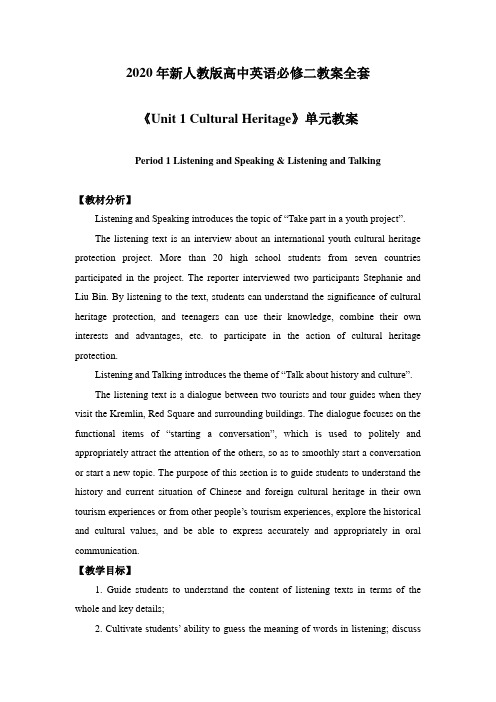
2020年新人教版高中英语必修二教案全套《Unit 1 Cultural Heritage》单元教案Period 1 Listening and Speaking & Listening and Talking【教材分析】Listening and Speaking introduces the topic of “Take part in a youth project”.The listening text is an interview about an international youth cultural heritage protection project. More than 20 high school students from seven countries participated in the project. The reporter interviewed two participants Stephanie and Liu Bin. By listening to the text, students can understand the significance of cultural heritage protection, and teenagers can use their knowledge, combine their own interests and advantages, etc. to participate in the action of cultural heritage protection.Listening and Talking introduces the theme of “Talk about history and culture”.The listening text is a dialogue between two tourists and tour guides when they visit the Kremlin, Red Square and surrounding buildings. The dialogue focuses on the functional items of “starting a conversation”, which is used to politely and appropriately attract the attention of the others, so as to smoothly start a conversation or start a new topic. The purpose of this section is to guide students to understand the history and current situation of Chinese and foreign cultural heritage in their own tourism experiences or from other people’s tourism experiences, explore the historical and cultural values, and be able to express accurately and appropriately in oral communication.【教学目标】1. Guide students to understand the content of listening texts in terms of the whole and key details;2. Cultivate students’ ability to guess the meaning of words in listening; discusswith their peers how to participate in cultural heritage protection activities.3. Instruct students to use functional sentences of the dialogue such as “I beg your pardon, but…” “Forgive me for asking, but…” and so on to start the conversation more politely and appropriately.【教学重难点】1. Guide students to understand the content of listening texts in terms of the whole and key details;2. Cultivate students’ ability to guess the meaning of words in listening; discuss with their peers how to participate in cultural heritage protection activities.3. Enable students to use the functional items of “starting a conversation”, which is used to smoothly start a conversation or start a new topic.【教学过程】Part 1: Listening and SpeakingStep 1: Lead inThe teacher is advised to talk about the meaning of the word “Heritage”.Boys and girls, before our listening, let’s work in pairs and discuss the meaning of the word “Heritage”.What does the word “heritage” mean? Share your ideas about your understanding of it and you can use examples to illustrate your meaning.Heritage means the traditional beliefs, values, customs, etc. of a family, country or society.For example, the Great Wall is the heritage of China.Step 2: PredictionAfter their small talk, the teacher can ask students to predict what the listening text is about by looking at the pictures.The listening text is probably about how to protect a famous heritage site by some students.Step 3: Summary of the main ideaThen play the radio which is about an interview about an international youth cultural heritage protection project. And after finishing listening for the first time, the students need to solve the following tasks.1. Listen to the conversation and sum up the main idea.Youths from seven countries are working together to protect cultural relics on Mount Tai.2. Listen again and help the reporter to complete the interview notes.International youth project, 23 high school students from 7 countriesMount Tai, one of the most famous mountains in ChinaIt has been protected for more than 3,000 years.22 temples, around 1,800 stones with writing on themDai Temple on Mount Tai; over 6,000 stepsStep 4: Guessing the meaning of the unknown wordsListen to the conversation again and use the context to guess the meaning of the words below. Tell the reasons why you guess so.Preserve: to protectReason: the word means the same of a word I knowPromote: to help sth to happen or developReason: The word is explained by the speakerStep 5: Speaking ProjectWork in pairs or groups and role play a conversation.Suppose you are a reporter and interviewing the students who devote their timeto protecting the heritage.Reporter: It is said that you are one of the volunteers to preserve the pine trees on Mount Huang. What are you guys doing?V olunteer: We are making some signs which are designed to educate people to protect the pine trees.V olunteer: Besides, we took a lot of pictures of pine trees and create an app which aims to promote people’s awareness of protecting the precious trees.Reporter: Sounds great and anything else?V olunteer: We often wear volunteer clothes and send some brochures in the park to call on more people to protect the trees.Reporter: Does your hard work pay off?V olunteer: Definitely. More and more tourists are now stopping carving names on the trees or climbing the trees.Part 2: Listening and TalkingStep1: Listen to the tape, which is about a dialogue between two tourists and a tour guide when they visit the Kremlin, Red Square and surrounding buildings for the first time, and then ask the students to solve the following tasks.1. Listen to the conversation and answer(1).Where are the speakers?On a street.(2).What are they doing?Sightseeing.2. What do you know about the Kremlin and Red Square? Listen again and complete the fact sheet.Step 2: Speaking ProjectActivity 3 on page 7.Work in groups. Choose a cultural site that you like and role-play a conversation between some tourists and their tour guide. Take turns to play the different roles.Step 3 HomeworkAccording to Activity 3, write down a conversation between the tourist and his/her guide.Unit 1 Cultural HeritagePeriod 2 Reading and Thinking:From Problems to Solutions【教材分析】1. This section focuses on “Understanding how a problem was solved”, which is aimed to guide students to analyze and discuss the challenges and problems faced by cultural heritage protection during the construction of Aswan Dam, as well as the solutions. On the basis of understanding, students should pay attention to the key role of international cooperation in solving problems, and attach importance to the balance and coordination between cultural heritage protection and social and economic development. Students are encouraged to face challenges actively, be good at cooperation, and make continuous efforts to find reasonable ways and means to solve problems.【教学目标】1. Enable students to understand the main information and text structure of the reading text;2. Motivate students to use the reading strategy “make a timeline” according to the appropriate text genre;3. Enable students to understand how a problem was solved;4. Enable students to understand the value of protecting cultural heritage by teamwork and global community;【教学重难点】1. Guide students to pay attention to reading strategies, such as prediction, self-questioning and scanning.2. Help students sort out the topic language about protecting cultural relics and understand the narrative characteristics of “time-event” in illustrative style3. Lead students to understand the value of protecting cultural heritage by teamwork and global community;【教学过程】1. PredictionStep 1 Predicting the main idea of the passageLook at the title and the pictures, and then predict what the passage will be about.Q: What will be talked about?Step 2: Fast reading tasksTask of the first fast reading:Read quickly and figure out the key words of each paragraph.•Paragraph 1: challenge•Paragraph 2: proposal led to protests•Paragraph 3: committee established•Paragraph 4: brought together•Paragraph 5: success•Paragraph 6: spiritTask of the second fast reading:1. Why did the Egyptian government want to build a new dam in the 1950s?2. Why did the building of the dam lead to protests?3. How did the government save the cultural relics?4. Which one can describe the project?A. Successful.B. Negative.C. Useless.D. Doubtful.5. What can be learned from the Aswan Dam project?Step 3: Careful reading tasksRead more carefully and answer the following questions.1. What do “problems” refer to and what do “solutions” refer to?2. Find out the numbers in paragraph four and explain why the author used exact numbers instead of expressions like many?3. What can you infer from “Over the next 20 years, thousands of engineers and workers rescued 22 temples and countless cultural relics”?4. What can you infer from “Fifty countries donated nearly 80 million to the project”?The project cost a lot of money.5. Before the building of the dam, what problems did the Nile River bring to the Egyptian?6. What words can you think of to describe the working process of the project?Step 4: ConsolidationDivide the passage into three parts and get the main idea of each part.Part 1 (Paragraph 1)The introduction of the topicKeeping the right balance between progress and the protection of cultural sites is a big challenge.Part 2 (Paragraphs 2-5)The process of saving cultural relics•Big challenges can someti mes lead to great solutions.•The Egyptian government wanted to build a new dam, which would damage many cultural relics.•The government turned to the UN for help.•Experts made a proposal for how to save cultural relics after a lot of efforts and the work began.•Cultural relics were taken down and moved to a safe place.•Countless cultural relics were rescued.Step 7 Homework:Review what we have learned and find out the key language points in the text.Unit 1 Cultural HeritagePeriod 3 Discovering Useful StructureRestrictive relative clauses【教材分析】This teaching period mainly deals with grammar “restrictive relative clauses.” To begin with, teachers should lead students to revise what they have learned about the relative pronouns and relative adverbs. And then, teachers move on to stress more special cases concerning this grammar, such as the “preposition+relative pronouns which and whom” and cases where we can omit the relative pronouns. This period carries considerable significance to the cultivation of students’ writing competence and lays a solid foundation for the basic appreciation of language beauty. The teacher is expected to enable students to master this period thoroughly and consolidate the knowledge by doing some exercises.【教学目标】1. Guide students to review the basic usages of relative pronouns and adverbs of attributive clauses.2. Lead students to learn to use some special cases concerning restrictive relative clauses flexibly.2. Enable students to use the basic phrases structures flexibly.3. Strengthen students’ great interest in gram mar learning.【教学重难点】1. Help students to appreciate the function of relative pronouns and adverbs of attributive clauses in a sentence2. Instruct students to write essays using the proper relative pronouns and adverbs of attributive clauses.【教学过程】本节语法思考:定语从句在复合句中的作用是什么?关系词有哪些?定语从句在复合句中的作用相当于形容词,它在句中作定语修饰名词或代词。
人教版高中英语必修二教案
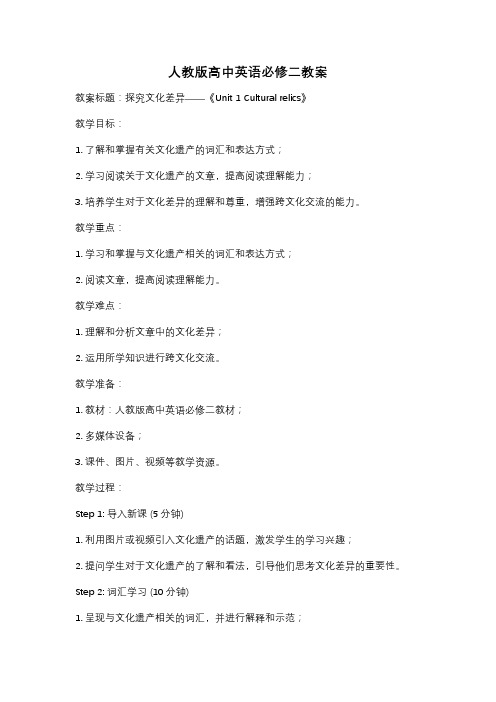
人教版高中英语必修二教案教案标题:探究文化差异——《Unit 1 Cultural relics》教学目标:1. 了解和掌握有关文化遗产的词汇和表达方式;2. 学习阅读关于文化遗产的文章,提高阅读理解能力;3. 培养学生对于文化差异的理解和尊重,增强跨文化交流的能力。
教学重点:1. 学习和掌握与文化遗产相关的词汇和表达方式;2. 阅读文章,提高阅读理解能力。
教学难点:1. 理解和分析文章中的文化差异;2. 运用所学知识进行跨文化交流。
教学准备:1. 教材:人教版高中英语必修二教材;2. 多媒体设备;3. 课件、图片、视频等教学资源。
教学过程:Step 1: 导入新课 (5分钟)1. 利用图片或视频引入文化遗产的话题,激发学生的学习兴趣;2. 提问学生对于文化遗产的了解和看法,引导他们思考文化差异的重要性。
Step 2: 词汇学习 (10分钟)1. 呈现与文化遗产相关的词汇,并进行解释和示范;2. 学生跟读、模仿,并进行词汇拓展和运用。
Step 3: 阅读理解 (25分钟)1. 分发阅读材料,让学生阅读并回答相关问题;2. 学生小组讨论,分享答案并进行解释;3. 整体讨论,引导学生理解文化差异对于人们生活的影响。
Step 4: 跨文化交流 (15分钟)1. 学生分组,每组选择一个文化遗产进行介绍;2. 学生利用所学知识和课件等资源,进行文化遗产介绍;3. 学生互相提问、交流,加深对于文化差异的理解和尊重。
Step 5: 总结和反思 (5分钟)1. 教师总结本节课的重点和难点,强调文化差异的重要性;2. 学生进行个人反思,思考如何更好地理解和尊重不同的文化。
教学延伸:1. 学生可以自主选择一个国家或地区的文化遗产进行深入研究,并进行展示;2. 学生可以通过阅读相关文章或观看纪录片等形式,进一步了解不同文化之间的差异和联系。
教学评估:1. 学生的课堂参与度;2. 学生在阅读理解和跨文化交流中的表现;3. 学生的个人反思和总结。
- 1、下载文档前请自行甄别文档内容的完整性,平台不提供额外的编辑、内容补充、找答案等附加服务。
- 2、"仅部分预览"的文档,不可在线预览部分如存在完整性等问题,可反馈申请退款(可完整预览的文档不适用该条件!)。
- 3、如文档侵犯您的权益,请联系客服反馈,我们会尽快为您处理(人工客服工作时间:9:00-18:30)。
新课标高中英语必修二教案合集Unit 1 Cultural relicsPart One: Teaching Design (第一部分:教学设计)Period 1: A sample lesson plan for Reading(IN SEARCH OF THE AMBER ROOM)Aims:To read about cultural relicsTo learn about The Restrictive and Non-Restrictive Attributive ClauseI. Warming upWarming up by definingGood morning, class. This period we are going to read about IN SEARCH OF THE AMBER ROOM. Before our reading, I’d like to know:A.What kind of old things are cultural relics?Are all the old things cultural relics?B.What is the definition and classification of cultural relics?C.To whom do cultural relics belong?Warming up by presentingHi, everyone. Let’s look at the screen. I’ll present yo u some pictures. They allbelong to cultural relics. Some of them are cultural sites. Some of them are natural sites. Please think these over:A.Can you name them out?B.Who have the right to confirm and classify them?Warming up by discussingNow, boys and girls, I met a “moral dilemma”. That means I must make a choice between the interests of the family and the interests of the society. Things are like this: My old granny happened to find an ancient vase under the tree in the earth of our garden. It’s so beautiful and special. Now, my family fell into a moral dilemma. Can you help us to make a decision:A: What should we do?B: Can we keep it for ourselves or report it to the government?C: Have you come across such a situation — to make a difficult choice?II. Pre-reading1. Looking and sayingWork in pairs. Look at the photos on the screen. All these relics are quite beautiful. But some of them were lost and ruined in history,such as Yuan MingYuan and the Amber Room. Please guess:A.What kinds of things can result in their disappearing?B.Why do they come into being once again?2. Explaining and sharingWork in groups of four. Tell your group mates:A.What do you know about the substance of “amber”?B.What do you know about the cultural relics “the Amber Room”?III. Reading1. Reading aloud to the recordingNow please listen and read aloud to the recording of the text IN SEARCH OFTHE AMBER ROOM. Pay attention to the pronunciation of each word and the pauses within each sentence. I will play the tape twice and you shall read aloud twice, too.2. Skimming and identifying the general idea of each paragraphNow please skim the text to get the key words and general idea of each paragraph.3.Scanning and analyzing the characteristics of the text.Since you have got to know the general ideas of each paragraph, can you tell me the characteristics of the passage, such as, the type of writing, the way of narrating, and the tense?4.Reading and understandingNext you are to read and underline all the useful expressions or collocations in the passage. Copy them to your notebook after class as homework.5. Reading and transferring informationRead the text again to complete the table, which lists all the numbers in the text.6.Reading and learningRead the text and learn more about the following proper nouns. You can surf onthe website after class:Ⅳ Closing downClosing down by doing exercisesTo end the lesson you are to do the comprehending exercises No. 1 and No. 2.Closing down by having a discussionA.Can you imagine the fate of the Amber Room? What is it?B.Do you think if it is worthwhile to reproduce the Amber Room? Why?Closing down by retelling the story of the Amber RoomWell, all of us have learned the history of the Amber Room. Let’s recall some key words and expressions on the board. You are to retell the story of the Amber Room:Period 2: A lesson plan for Learning about Language(The Restrictive and Non-Restrictive Attributive Clause)Aims:To learn about the restrictive and non-restrictive attributive clauseTo discover some useful words and expressionsTo discover some useful structuresProcedures:I. Warming upWarming up by discovering useful words and expressionsPlease turn to page 3. Do exercises 1, 2, 3 and 4 first. Please check your answers against your classmates’.Warming up by explainingNow, class, since you’ve read the passage, could you explain to me how to use the phrase “belong to”? The word “to” here is a preposition, indicating the possession, and is always followed by nouns or pronoun. Look at Ex 3. The preposition “at” indicates a state, condition or continuous activity. So we can replace them or express them by using a present-continuous tense.II. Learning about Attributive Clause1. What is an adjective Clause?An adjective clause is a dependent clause which takes the place of an adjective in another clause or phrase. Like an adjective, an adjective clause modifies a noun or pronoun, answering questions like “which?” or “what kind of?” Consider the following examples:Adjectivethe red coatAdjective clausethe coat which I bought yesterdayLike the word “red” in the first example, the dependent clause “which I bought yesterday” in the second example modifies the noun “coat.” Note that an adjective clause usually comes after what it modifies, while an adjective usually comes before.In formal writing, an adjective clause begins with the relative pronouns“who(m),” “that,” or “which.” In informal writing or speech, you may leave out the relative pronoun when it is not the subject of the adjective clause, but you should usually include the relative pronoun in formal, academic writing:informalThe books people read were mainly religious.formalThe books that people read were mainly religious.informalSome firefighters never meet the people they save.formalSome firefighters never meet the people whom they save.Here are some more examples of adjective clauses:the meat which they ate was taintedThis clause modifies the noun “meat” and answers the question “which meat?”.They’re talking about the movie which made him cryThis clause modifies the noun “movie” and answers the question “which movie?”.They are searching for the student who borrowed the bookThe clause modifies the pronoun “student” and answers the question “which student?”.Did I tell you about the author whom I met?The clause modifies the noun “author” and answers the question “whichaut hor?”.2. Restrictive & non restrictive clausesDo the following pairs of sentences mean the same thing?1a My uncle, who lives in London, is very rich.2b My uncle who lives in London is very rich.2a The policies, which were unpopular, were rejected by the voters.2b The policies which were unpopular were rejected by the voters.3a My niece, whose husband is out of work, will inherit the house, which I have always treasured.3b My niece whose husband is out of work will inherit the house which I have always treasured.The first sentence in each pair has a non-restrictive clause within two commas, and the second has a restrictive clause. A non-restrictive clause simply adds more information into the sentence and does not affect the meaning of the main clause: it is therefore bracketed off with commas (1a = an uncle who happens to live in London). Conversely, a restrictive clause defines its referent in the main clause more specifically and contributes significantly to the meaning of the sentence. Thus it is that particular uncle who lives in London who is referred to (1b). In 2a, all policies were unpopular and all were rejected, whereas in 2b only the policies that were unpopular were rejected. Note that in restrictive clauses the non-human relativepr onoun is either ‘that’ or ‘which’, whereas for human referents the relative pronoun can be either ‘who/m’ or ‘that’ (the man that/whom I will marry ....).3. A test on FORMAL ADJECTIVE CLAUSESDirections: Combine the sentences. Use formal written English.Use (b) as an adjective clause. Punctuate carefully.1) (a) An antecedent is a word. (b) A pronoun refers to this word.An antecedent ____2) (a) The blue whale is considered the largest animal that has ever lived.(b) It can grow to 100 feet and 150 tons.The blue whale ____3) (a) The plane was met by a crowd of 300. (b) Some of them had been waiting for more than 4 hours.The plane ____4) (a) In this paper, I will describe the basic process.(b) Raw cotton becomescotton thread by this process.In this paper, I will describe ____5) (a) The researchers are doing case studies of people to determine the importance of heredity in health and longevity.(b) These people’s families have a history of high blood pressure and heart disease.The researchers are doing case studies ____6) (a) At the end of this month, scientists at the institute will conduct their AIDS research. (b) The results of this research will be published within 6 months.At the end of this month, scientists ____7) (a) According to many educati on officials, ‘math phobia’(that is, a fear of mathematics) is a widespread problem. (b) A solution to this problem must and can be found.According to many education officials, ‘math phobia’ ____8) (a) The art museum hopes to hire a new administrator.(b) Under this person’s direction it will be able to purchase significant pieces of art.The art museum ____9) (a) The giant anteater licks up ants for its dinner.(b) Its tongue is longer than 30 centimeters (12 inches).The giant anteater ____10) (a) The anteater’s tongue is sticky.(b) It can go in and out of its mouth 160 times a minute.The anteater’s tongue ____III. Closing down by taking a quizQuiz on Attributive clauseSelect one answer from the choices provided after each sentence. The words you choose should fit the blank in the sentence. Don’t use the HINT buttons unless you really need them.1. As many children came were given some cakes.A. thatB. asC. whoD. whom2. The visitors saw rows of houses the roofs are red.A. on whichB. of whichC. whereD. that3. I usually take a nap after lunch, is my habit.A. which itB. as itC. asD. that4. Please tell me the way you did the job.A. howB. whereC. whichD. in which5 Is this museum some German friends visited the day before yesterday?A. the oneB. whichC. thatD. where6. The farmer uses wood to build a house to store grain.A. in whichB. whereC. thatD. with which7. I shall never forget the years I spent in the country with the farmers, has a great effect on my life.A. when, whichB. that, whichC. when, thatD. which, that8. Little has been done is helpful to our work.A. thatB. whatC. whichD. all that9. Perhaps this is the only market you can get such cheap goods.A. thatB. of whichC. by whichD. where10. We’ll put off the outing until next week, __we won’t be so busy.A. whenB. whichC. at whichD. in thatKey: 1~10:BBCDA ABADAPeriod 3: A lesson plan for using languageAims:To learn to tell facts from opinionsTo write a reply letterTo listen and speak about cultural relicsProceduresI. Warming upWarming up by questionsMorning, class. We always say, “We must respect facts and can’t wholly dependon one’s opinions”. But can you tell me:A.What does it mean when you say, “It is a fact”?B.What does it mean when you say, “It is an opinion”?Warming up by questioningTurn to page 5. Read the passage and tell me:A.If you want to go in for law against somebody, and if you want to win, what’s the most important thing you should do first?B.What makes a judge decide which eyewitnesses to believe and which not to believe.II. Guided reading1.Reading and definingRead the passage and define: What is a fact? What is an opinion? What is an evidence?2. Reading and translatingRead the passage and translate it into Chinese paragraph by paragraph. Tom, you are to do paragraph 1, please…3. Reading and underliningNext you are to read and underline all the useful expressions or collocations in the part. Copy them to your notebook after class as homework.4. ListeningNow, boys and girls, as we know, people have never stopped searching for the Amber Room. This time we’ll listen to what three people say they know about the missing Amber Room. Before we listen to t hem, I’ll present some related new words to you to help you understand them easily. Please look at the screen and read after me.5. Sharing and CorrectingWell done. Now share your forms with your partner and tell me in the three forms: What are facts? What are opinions? Li Ming, do you want a try?6. ReviewingWe often use some expressions to ask for opinions. What are they?Oh, yes. What do you think of …?Do you believe …?How can you be sure of …?How do you know that?And we often use some expressions to give opinions. What are they? Ok, Tom, Please. Oh, yes. They are: I think… / I don’t think… I don’t agree that… / I suppose that…7. DiscussingPlease look at exercise 3, and discuss which person gave the best evidence. Use the expressions above to help you. Before we discuss, let’s deal with the following discussion:A.What is the best evidence?B.How can we know which eyewitness is most believable?Well done. Let’s come to the discussion “Which person gave the best evidence?”8. Reading and writingSometimes we may fall into or face a moral choice. That is a moral dilemma. Let’s read the letter on page 7 and see what’s Johann’s choice and opinion. Ok, finished? Now answer the following questions:A.What’s Johann’s opinion about the Amber Room?B.What’s his father’s opinion about the things f ound by him?C.What happened to Johann when she was a pupil?9. Completing the letters A & B and then giving your own letters·When you write your letter, you may choose to agree or not agree with the writer.·You must give a reason why you agree or don’t agree with the writer.·Be sure to give an example from your own life so that the reader can better understand your opinion.Ⅲ Closing downClosing down by a debatingThere is a long ancient wall around a less developed town.It is reported it has a long history, dating back to over 5 century BC. The local government is collecting money to repair and rebuild the wall. It has cost a lot of money. Some of your classmates think it is not worth. Some think it’s a good way to develop the local economy. Now Group 1 and 2 against Group 3 and 4. Let’s have the debating.Closing down by dictation·The design for the room was of the fancy style popular in those days.·The room served as a small reception hall for important visitors.·The man who found the relics insist that it belongs to his family.·The room was completed the way she wanted it .·It was ready for the people of St. Petersburg to celebrate the 300th birthday of their city.·After that, what really happened to the Amber Room remains a mystery.·In a trial, a judge must decide which eyewitnesses to believe and which not to believe.·Is it something that more than one person believes?·A fact is anything that can be proved.·An opinion is what someone believes is true but has not been proved.Part Two: Teaching Resources (教学资源)Section 1: A text structure analysis of IN SEARCH OF THE AMBER ROOMI. Type of writing and summary of the ideaII. A tree diagramSection 2: Background information on culture relics I. What is a culture relic? 何谓“文化遗产”?Cultural relics are physical reminders of what different peoples valued in the past and continue to value now. Without these relics, we could not cherish cultural traditions as much or appreciate the lives of the people who practiced those traditions. Although we may not often consider it, cultural relics are not only the possession of one culture. In a larger sense, it can be said that they belong to all peoples. For these reasons, this unit describes cultural relics not from China but other places. Looking at it from another angle, it can also be said that cultural relics preserves some aspect of cultural heritage and each relic, regardless of whether the same hands created many examples of it, is still a unique cultural expression and contribution.II. The cultural relics of China in the world heritage site list《世界文化遗产名录》中的30处中国文遗产本单元的主题是“文化遗产”,学生很可能已经亲身接触过当地的文化遗产,或是能过电视、报纸等媒体对此有了一定的了解,因此,在课前教师可让学生列举国内外著名的文化遗产,然后对“文化遗产”给出定义、分类或划分标准。
